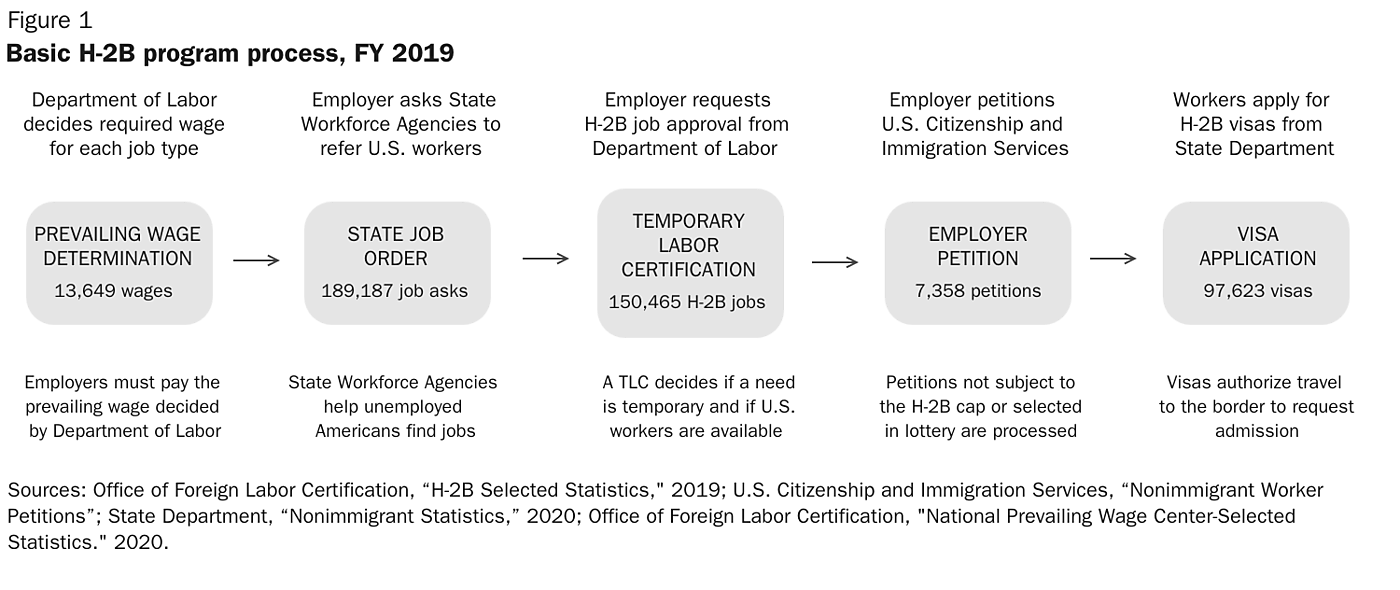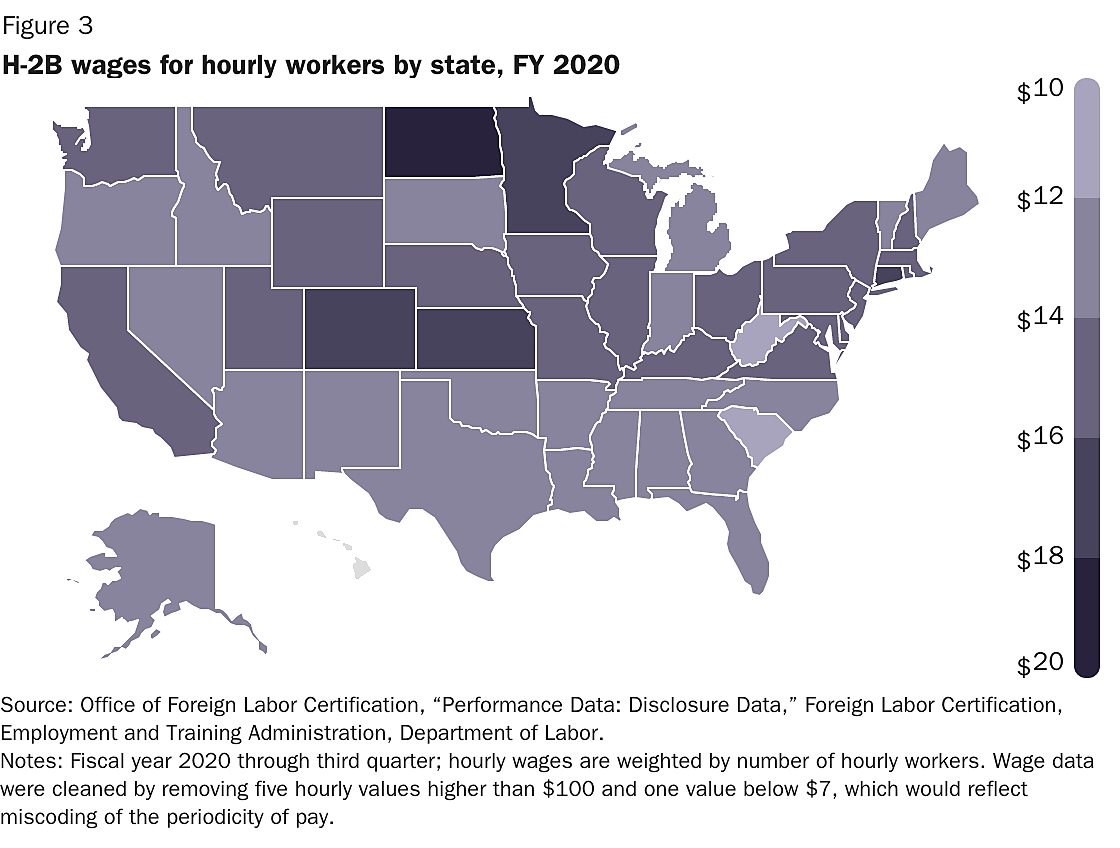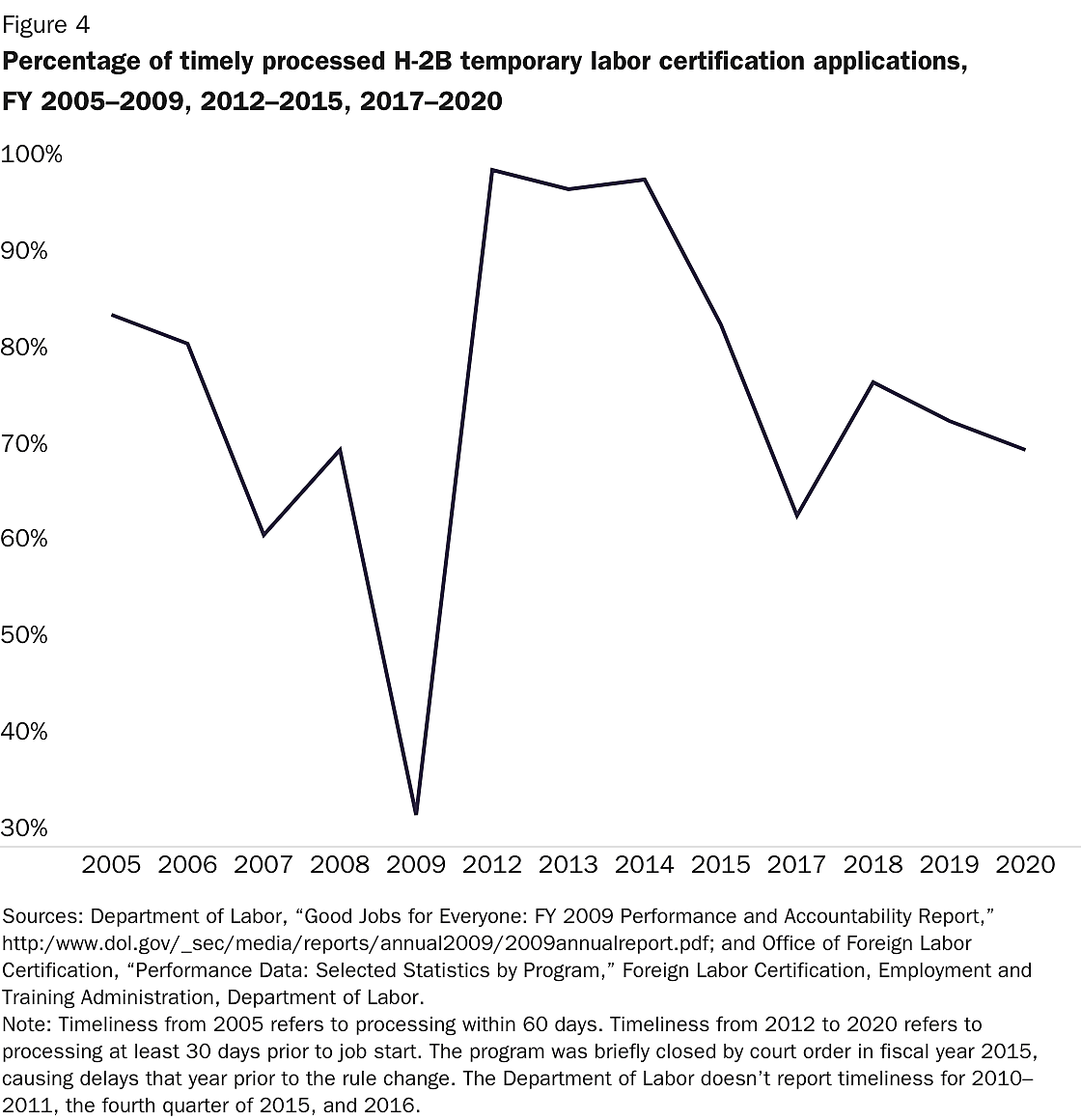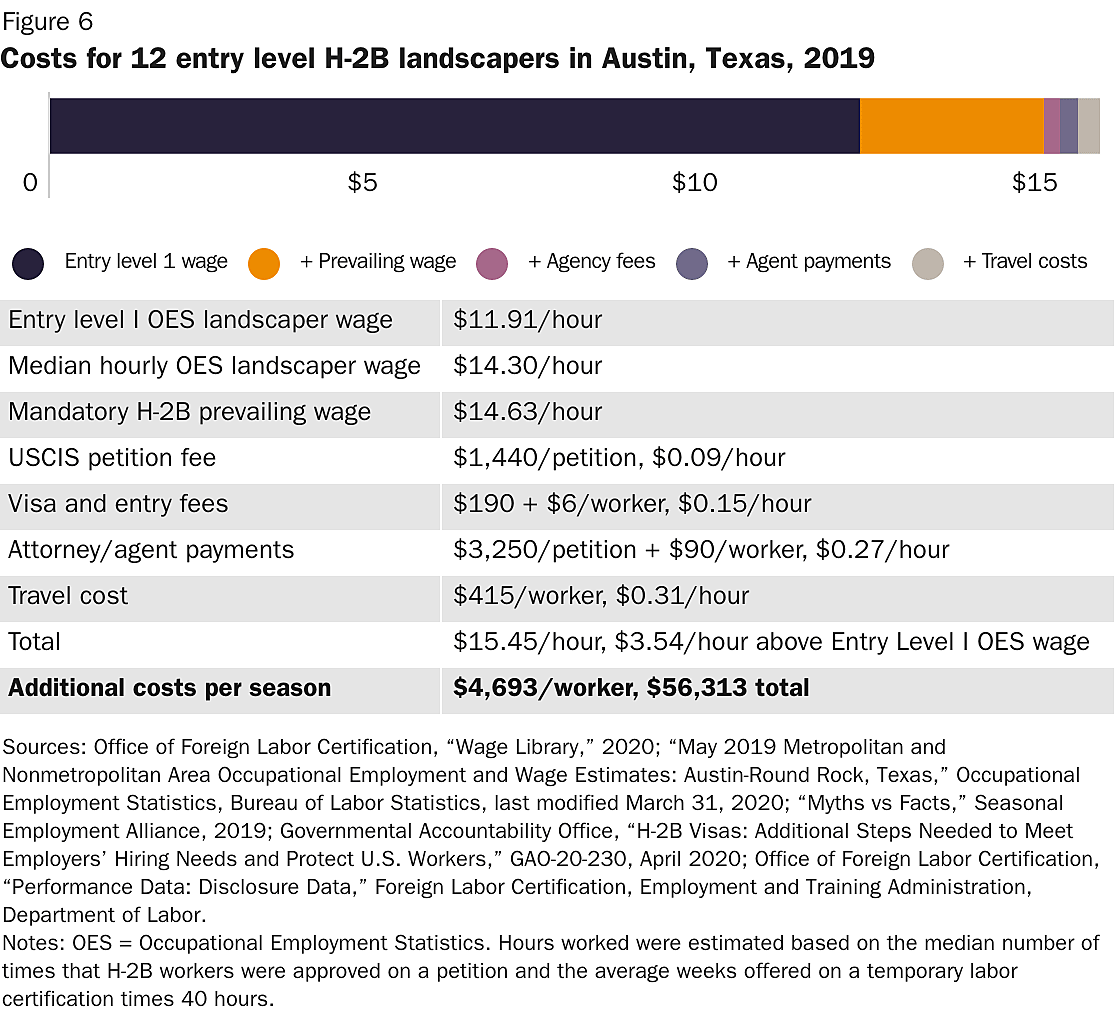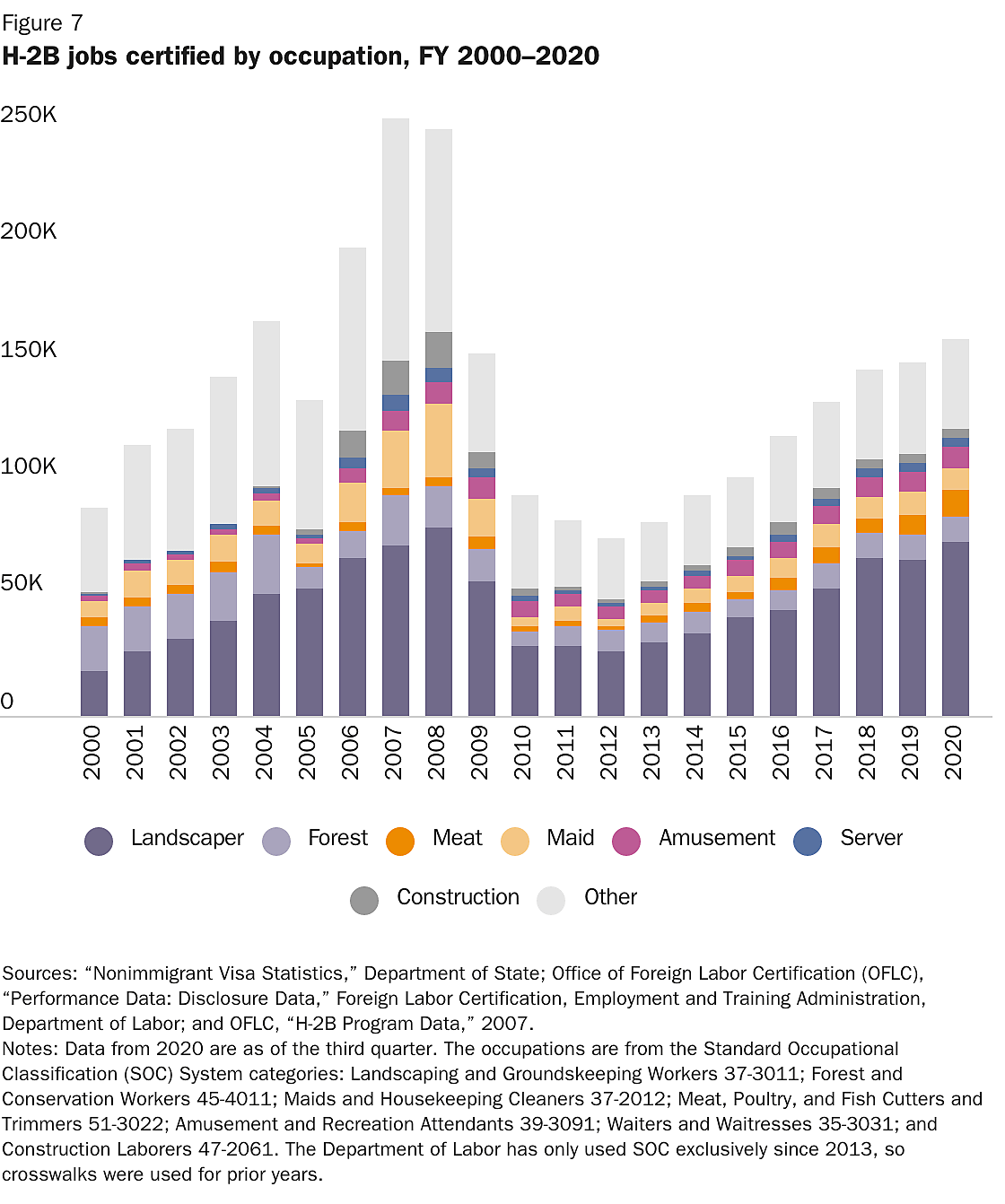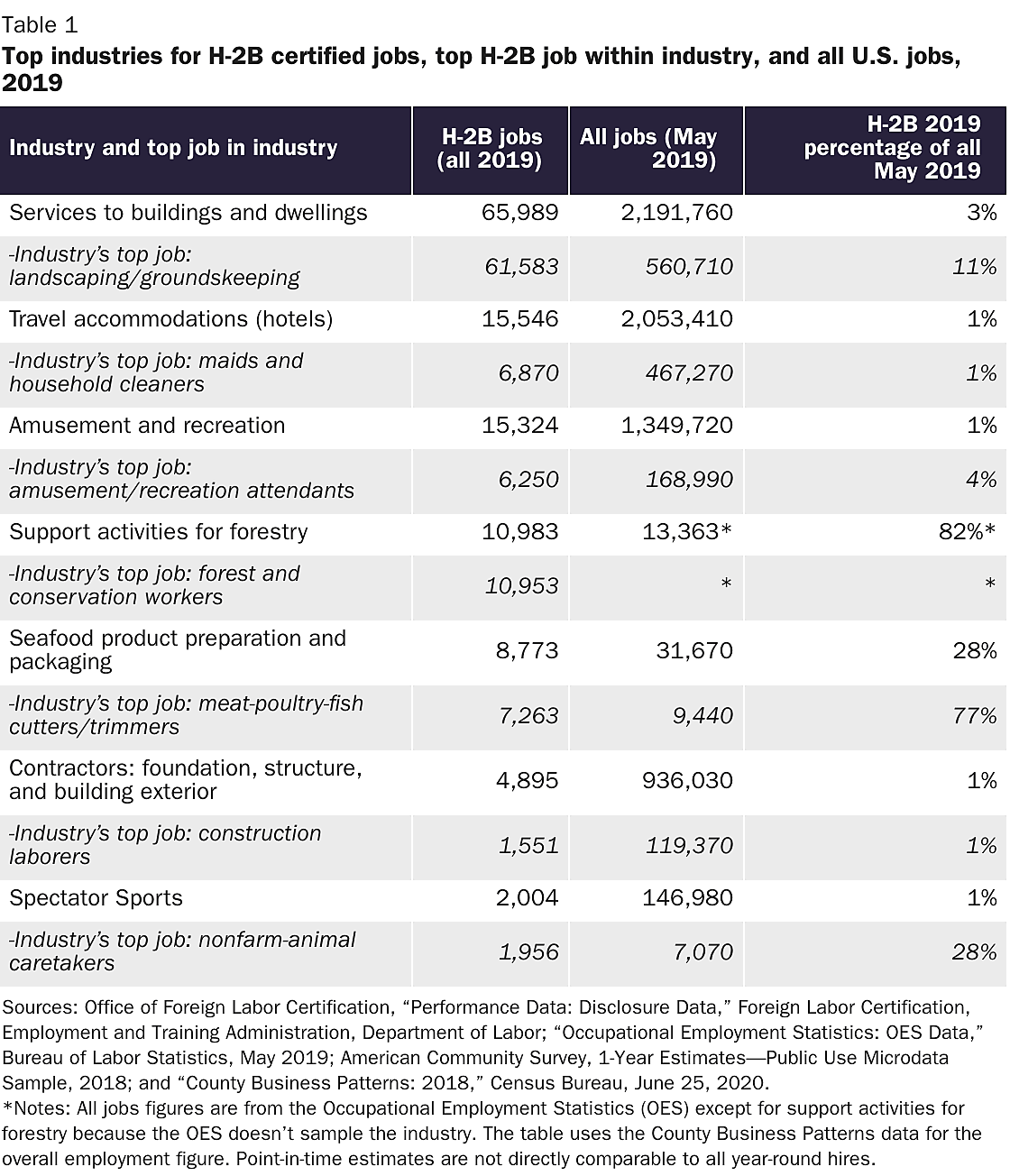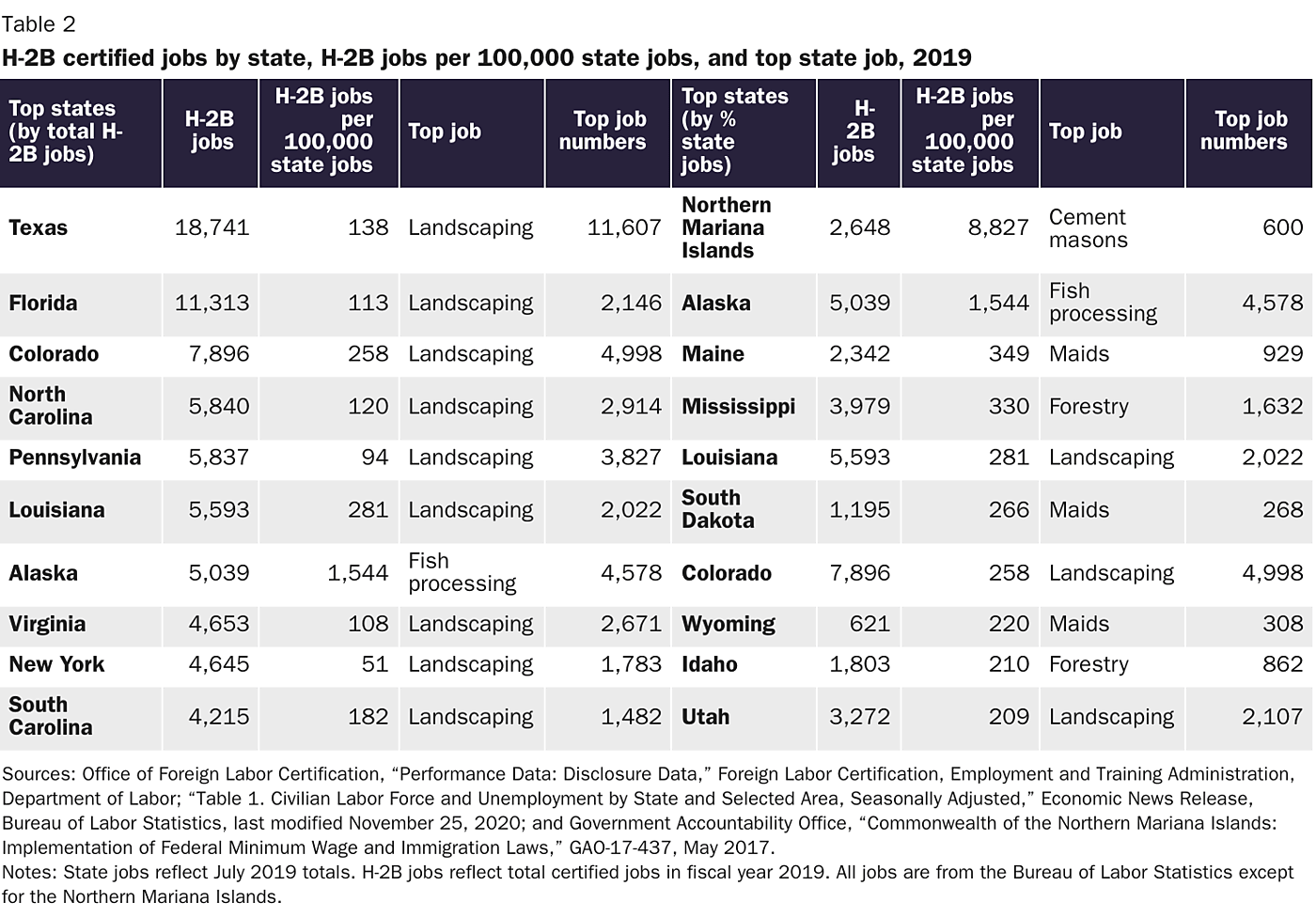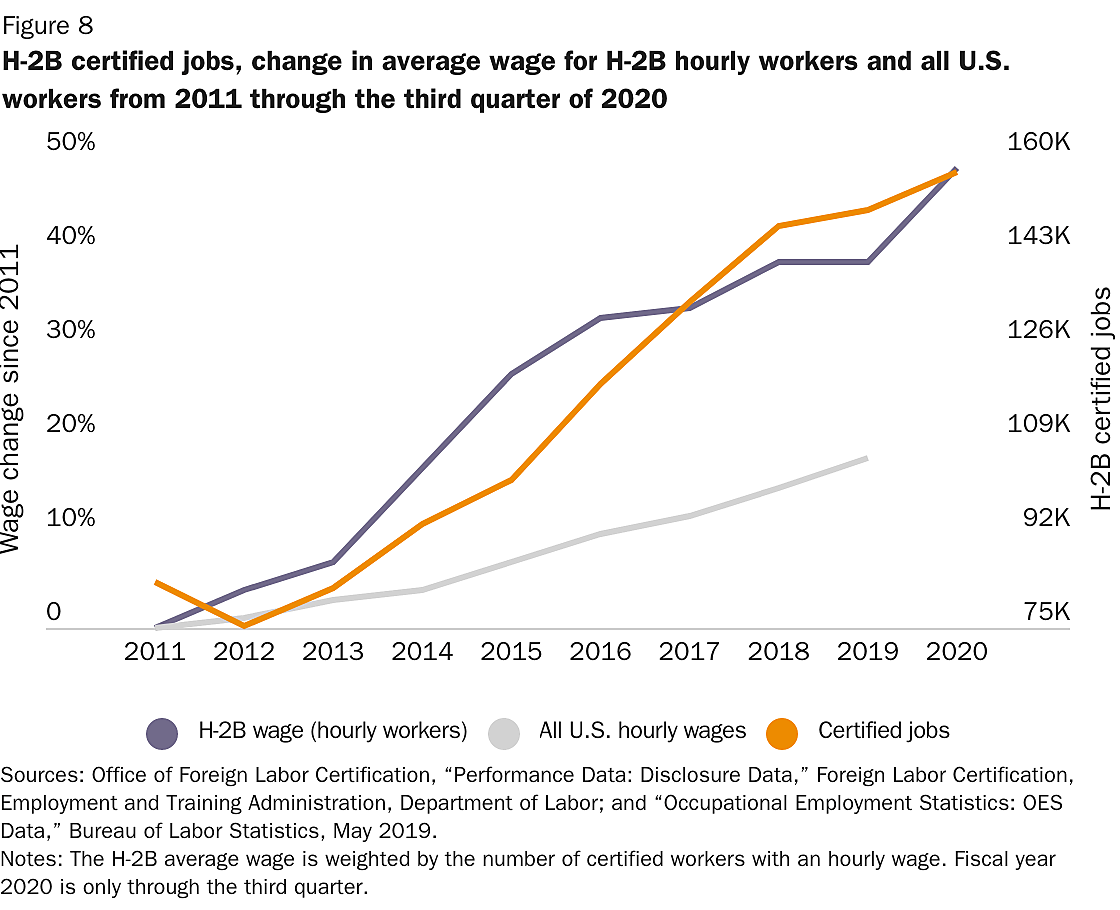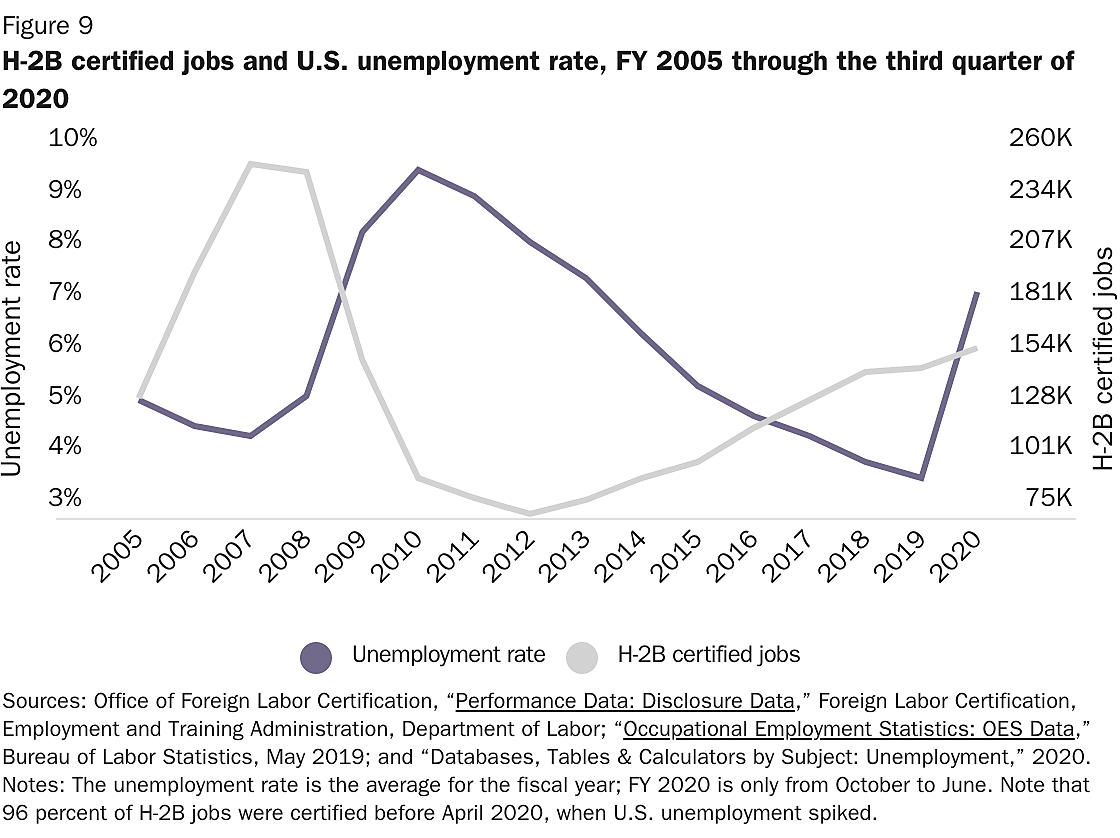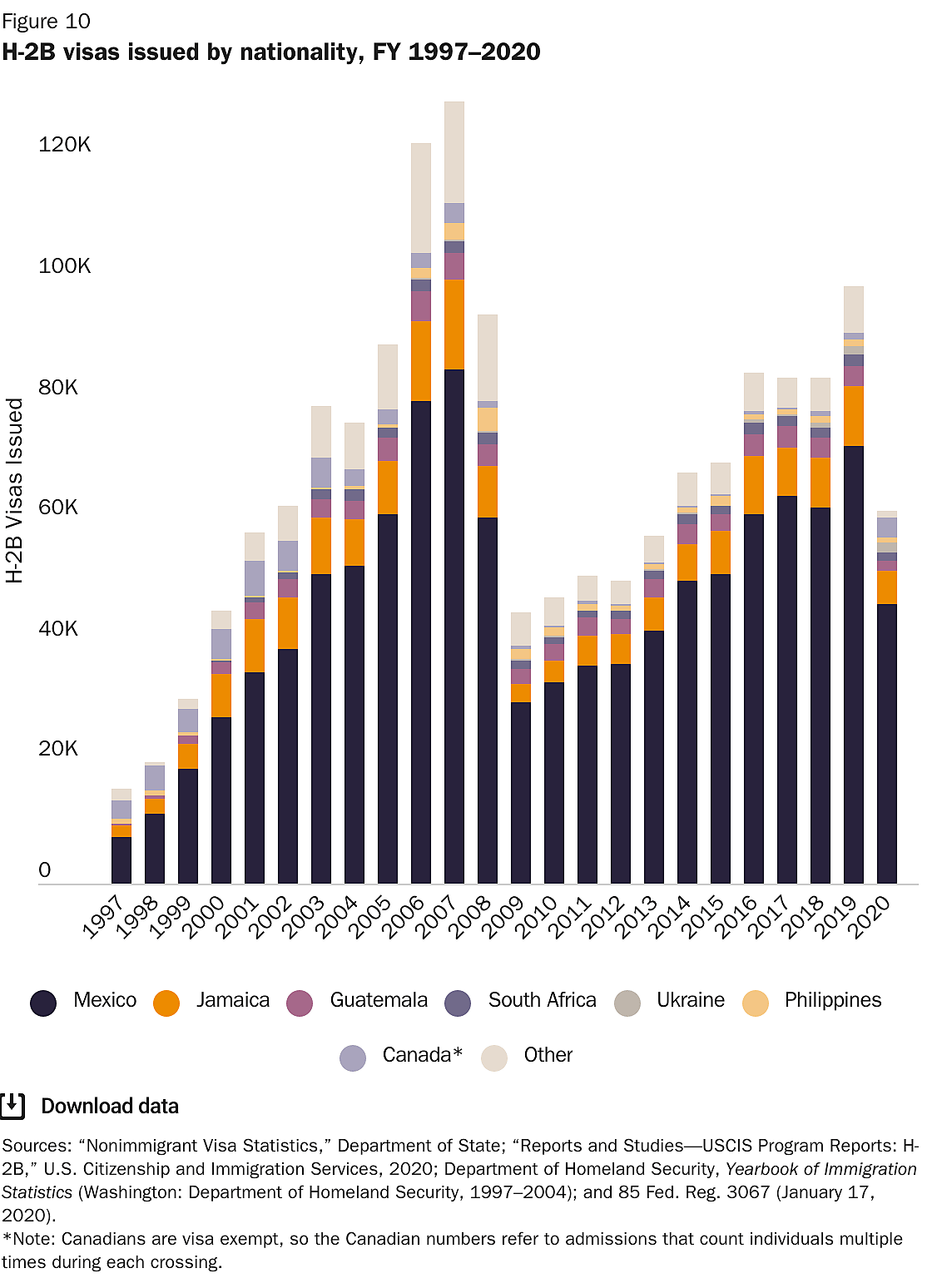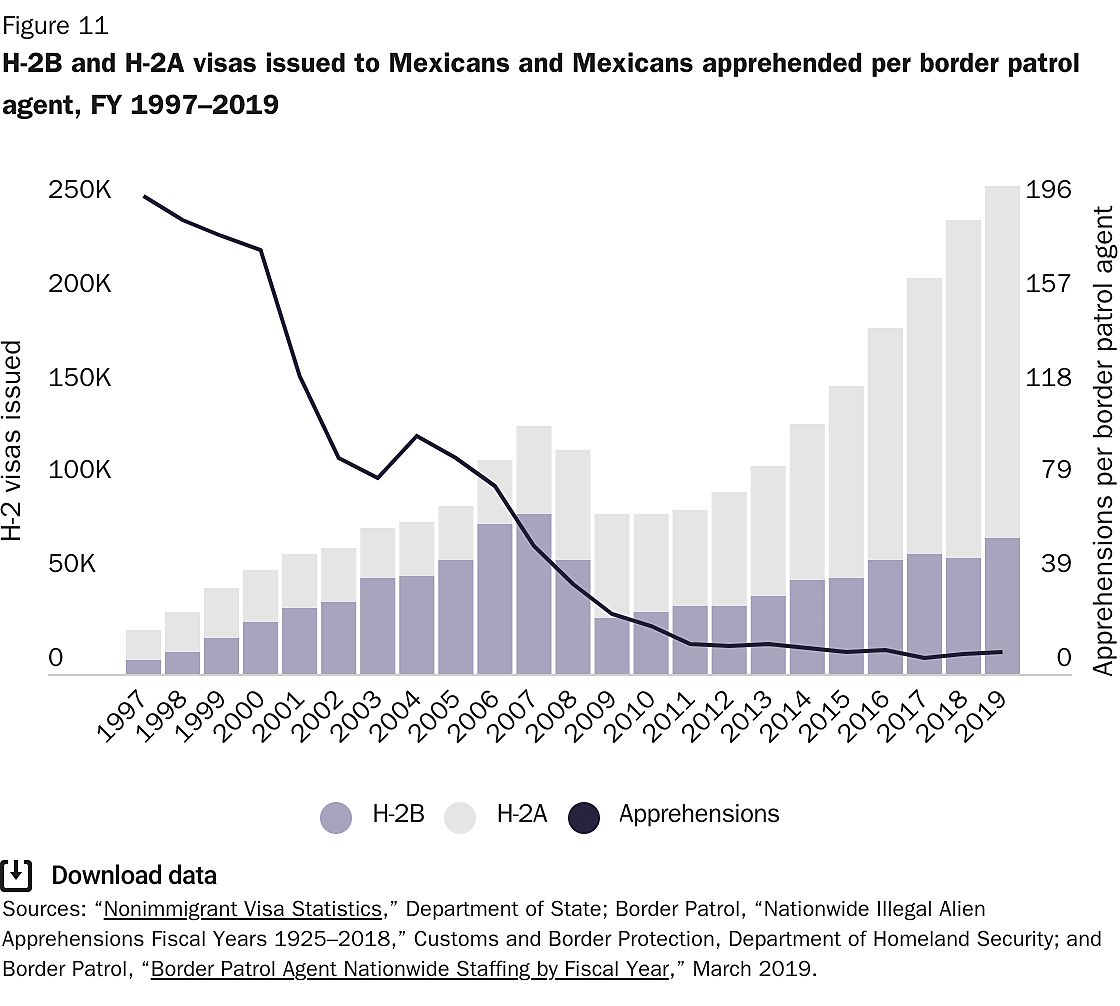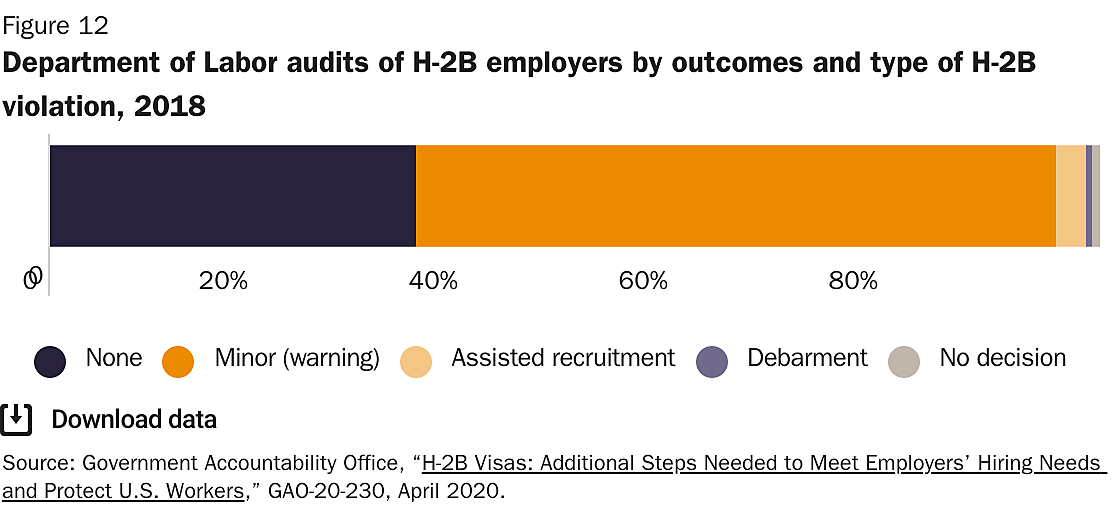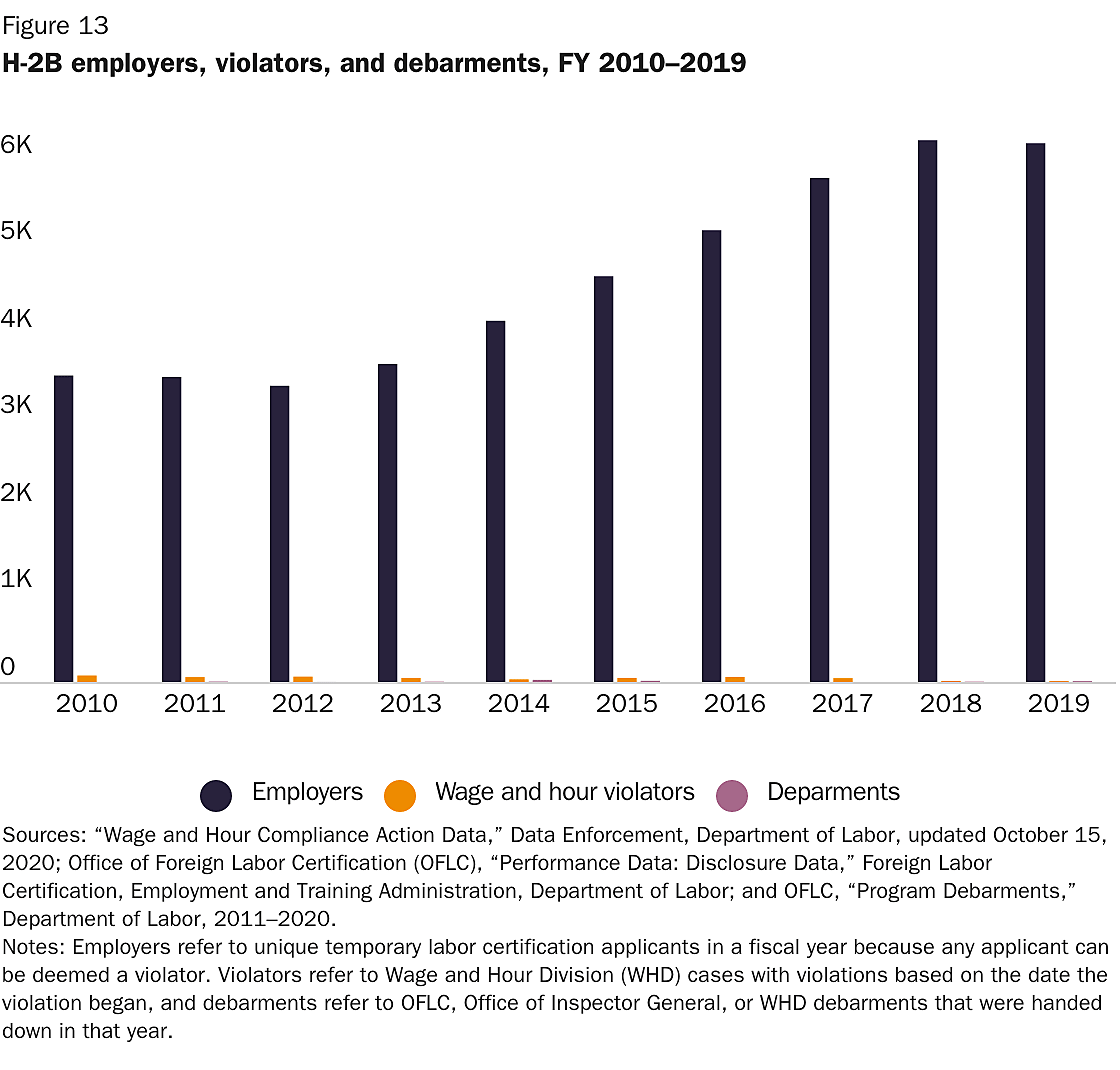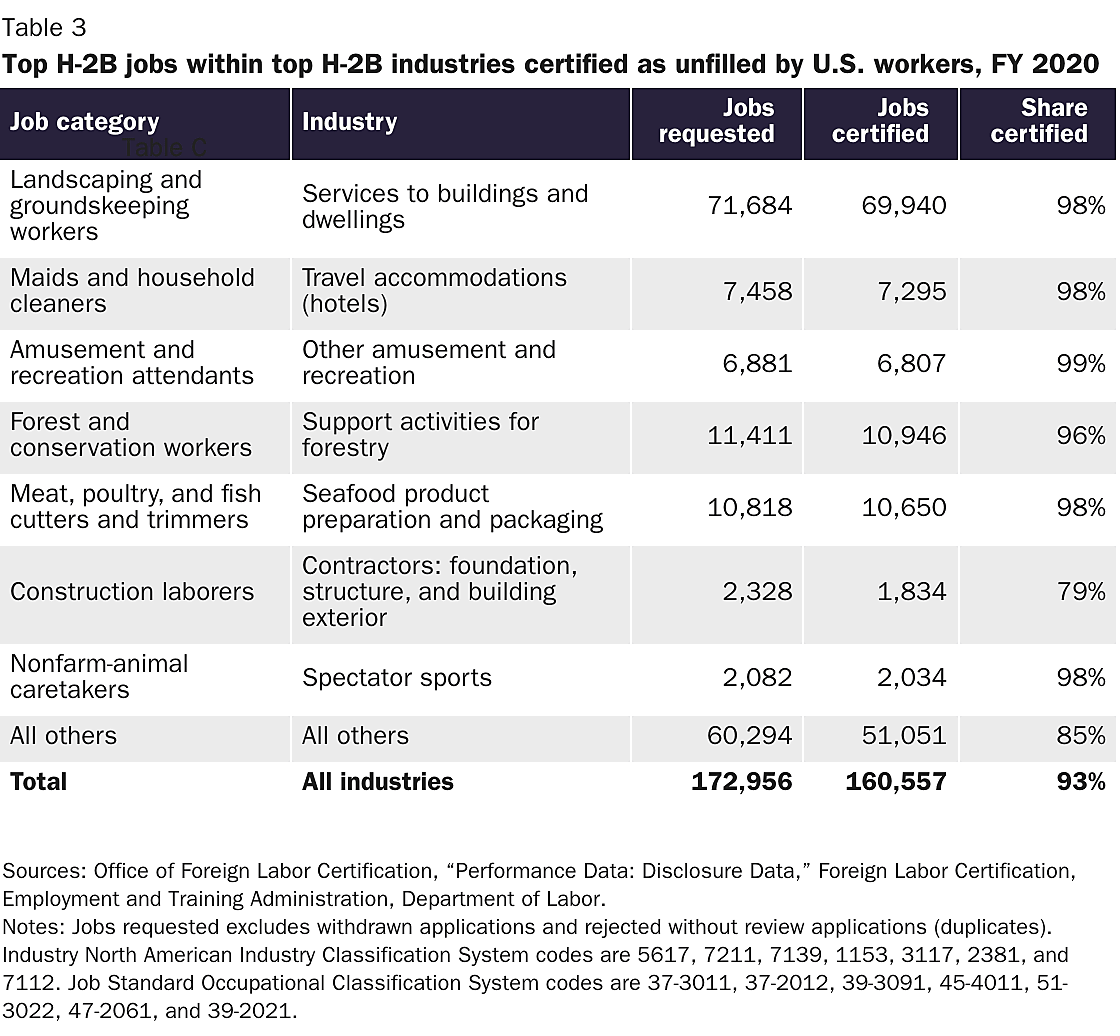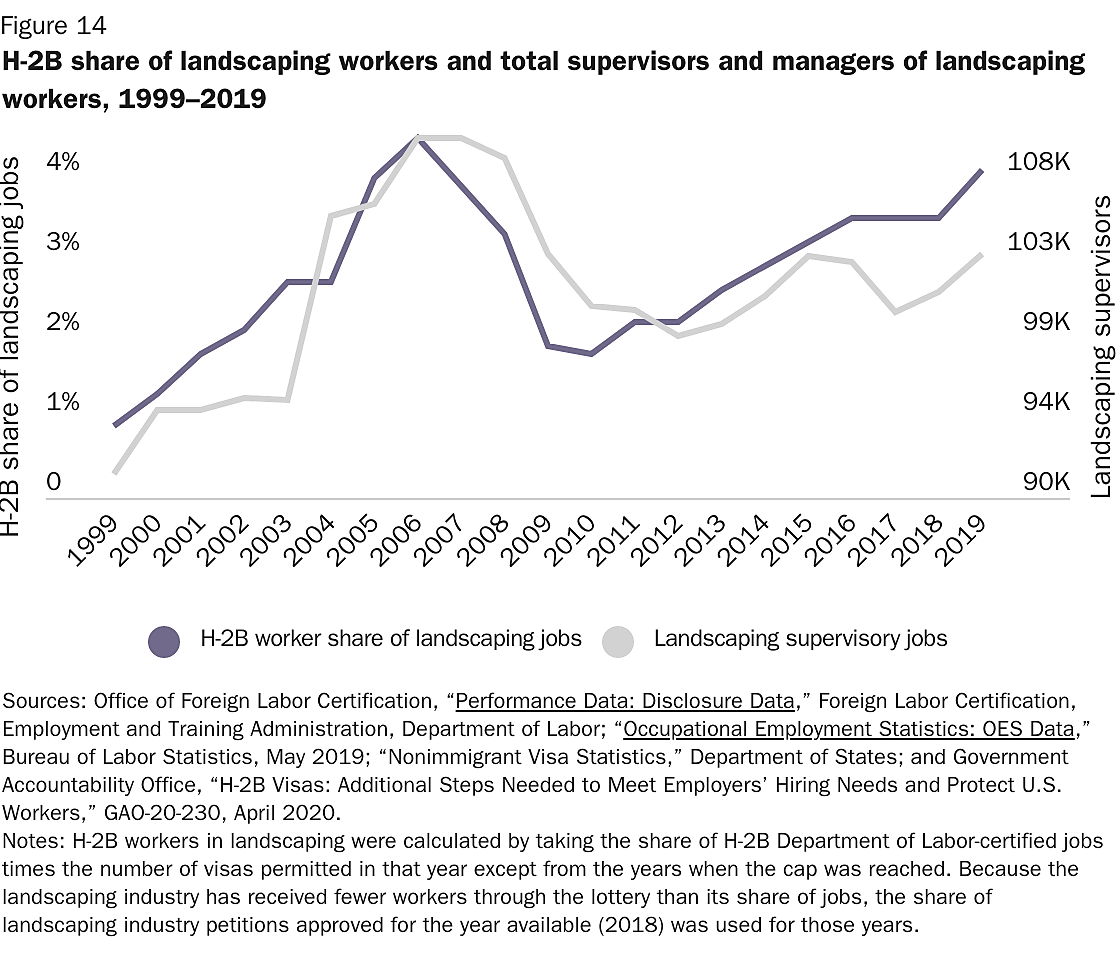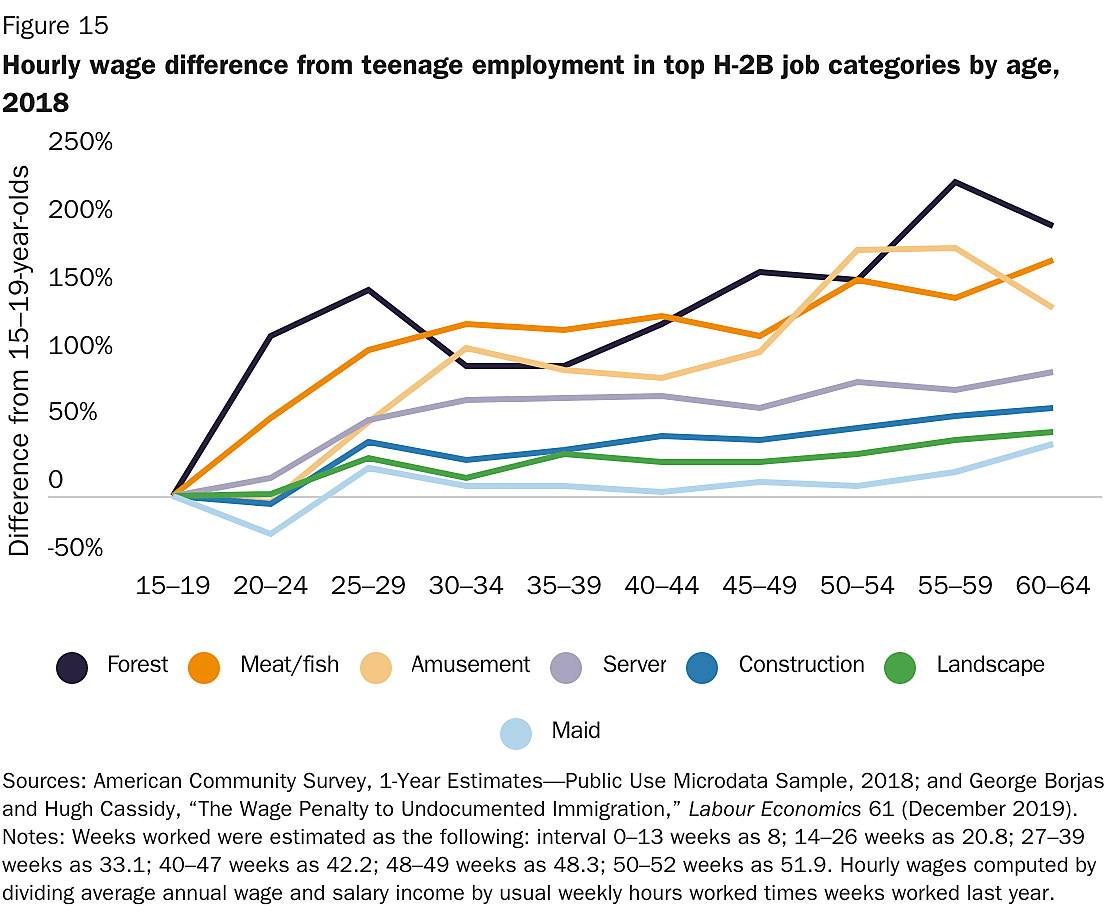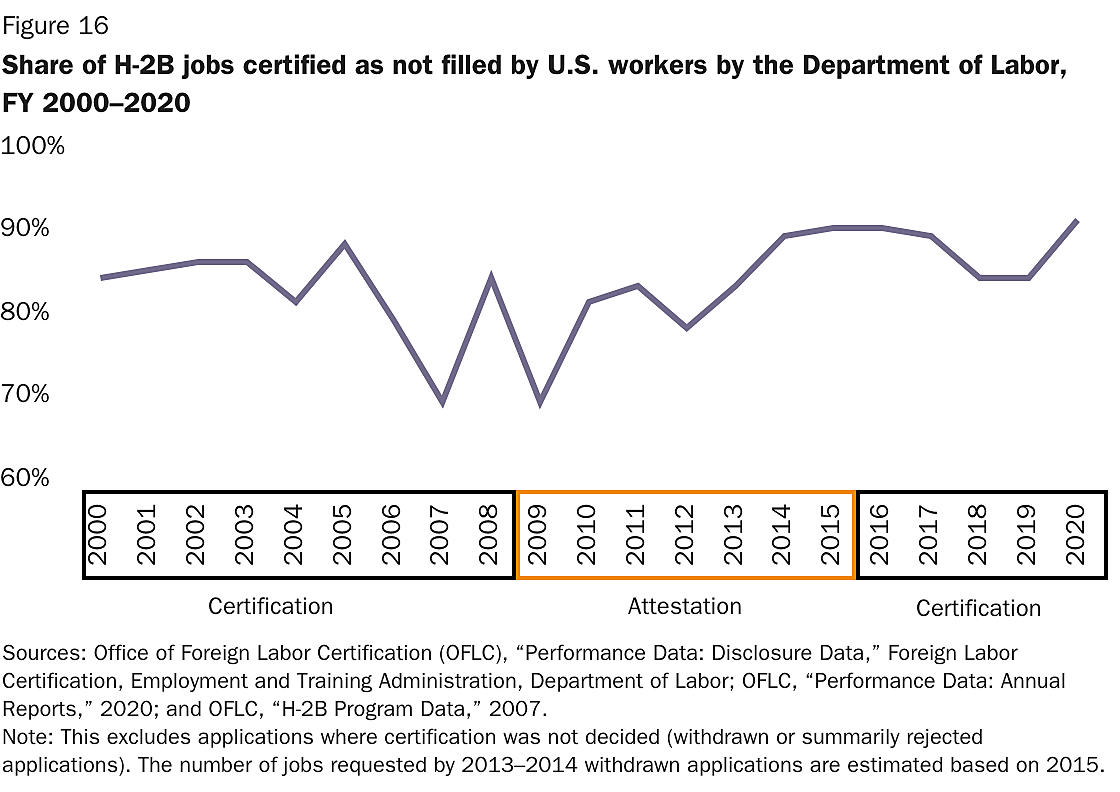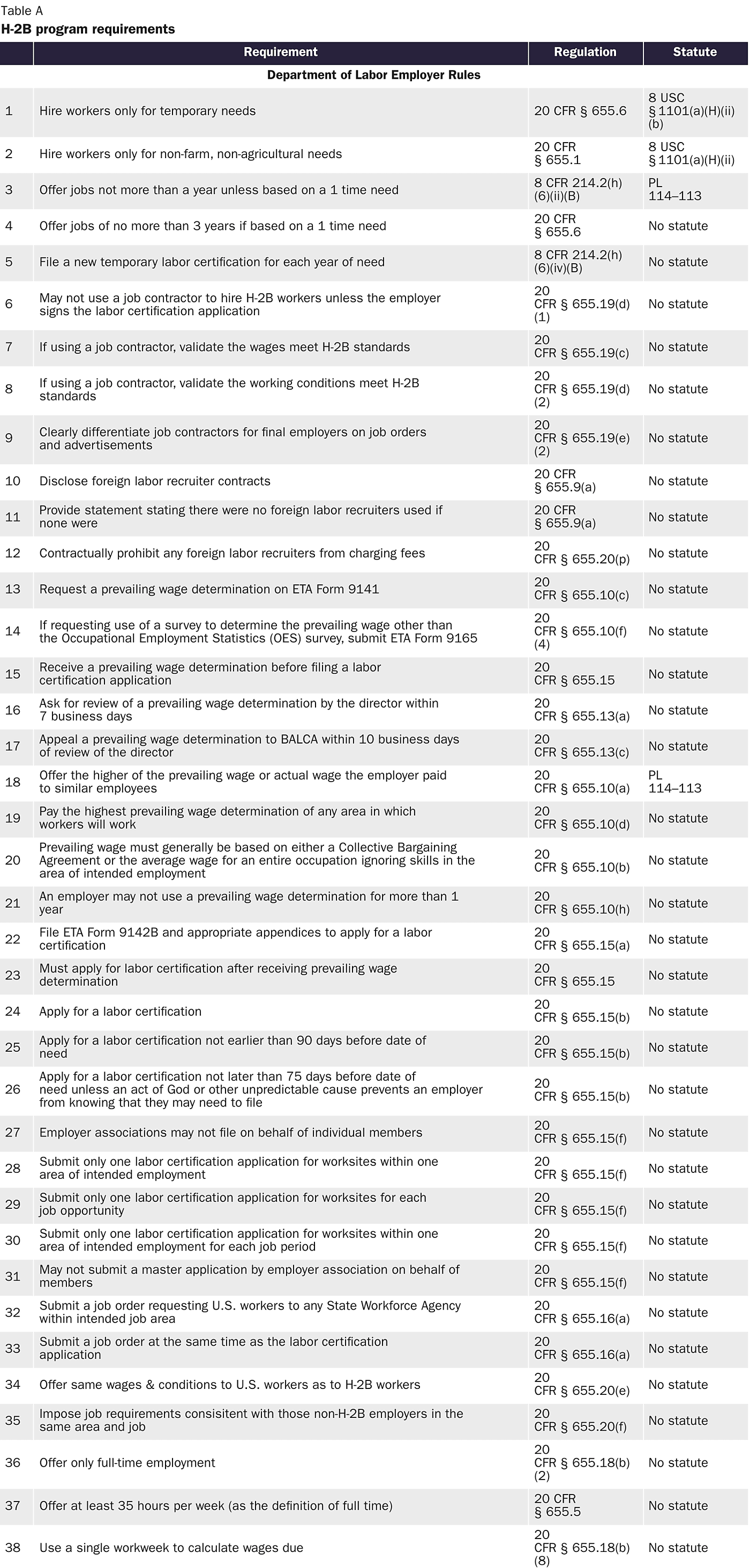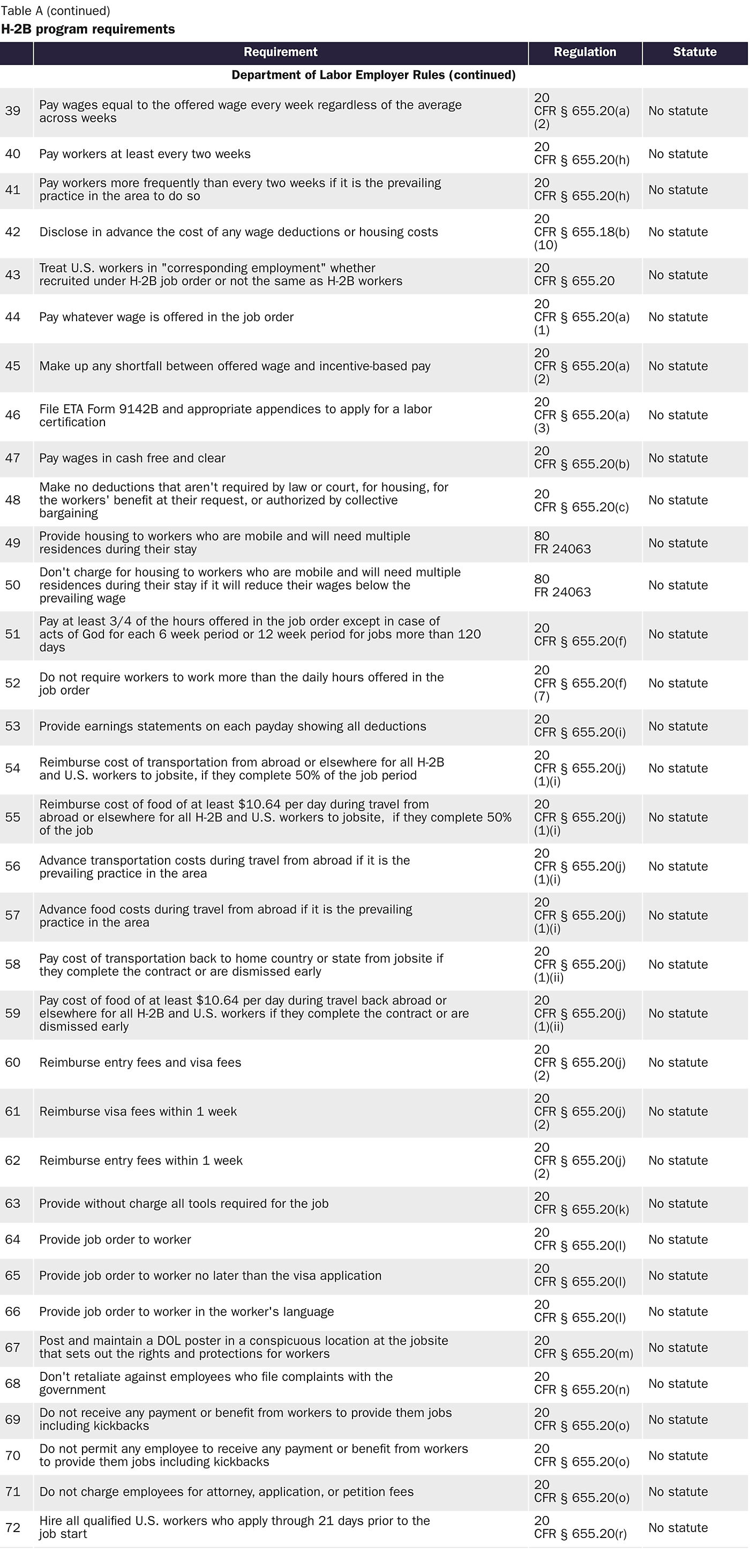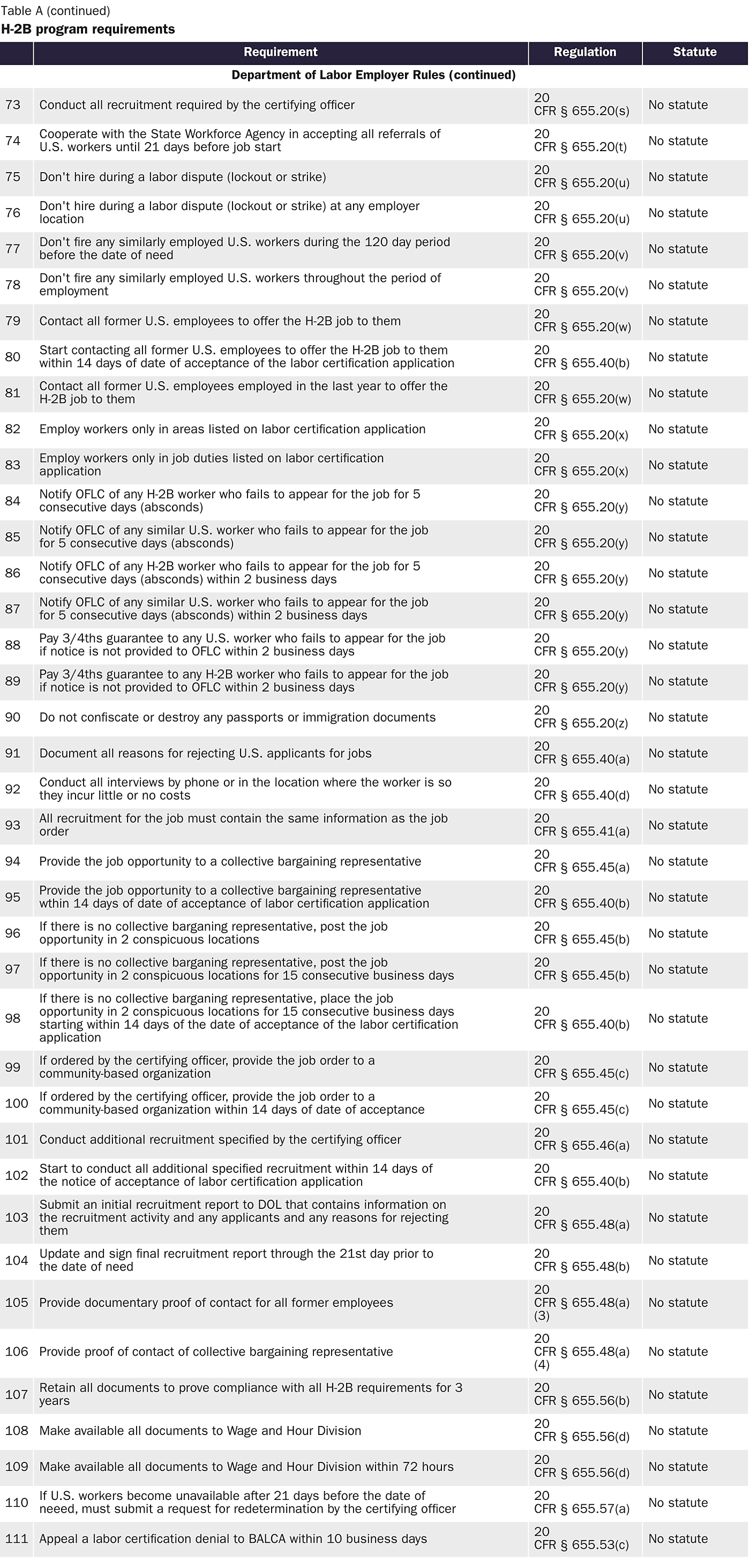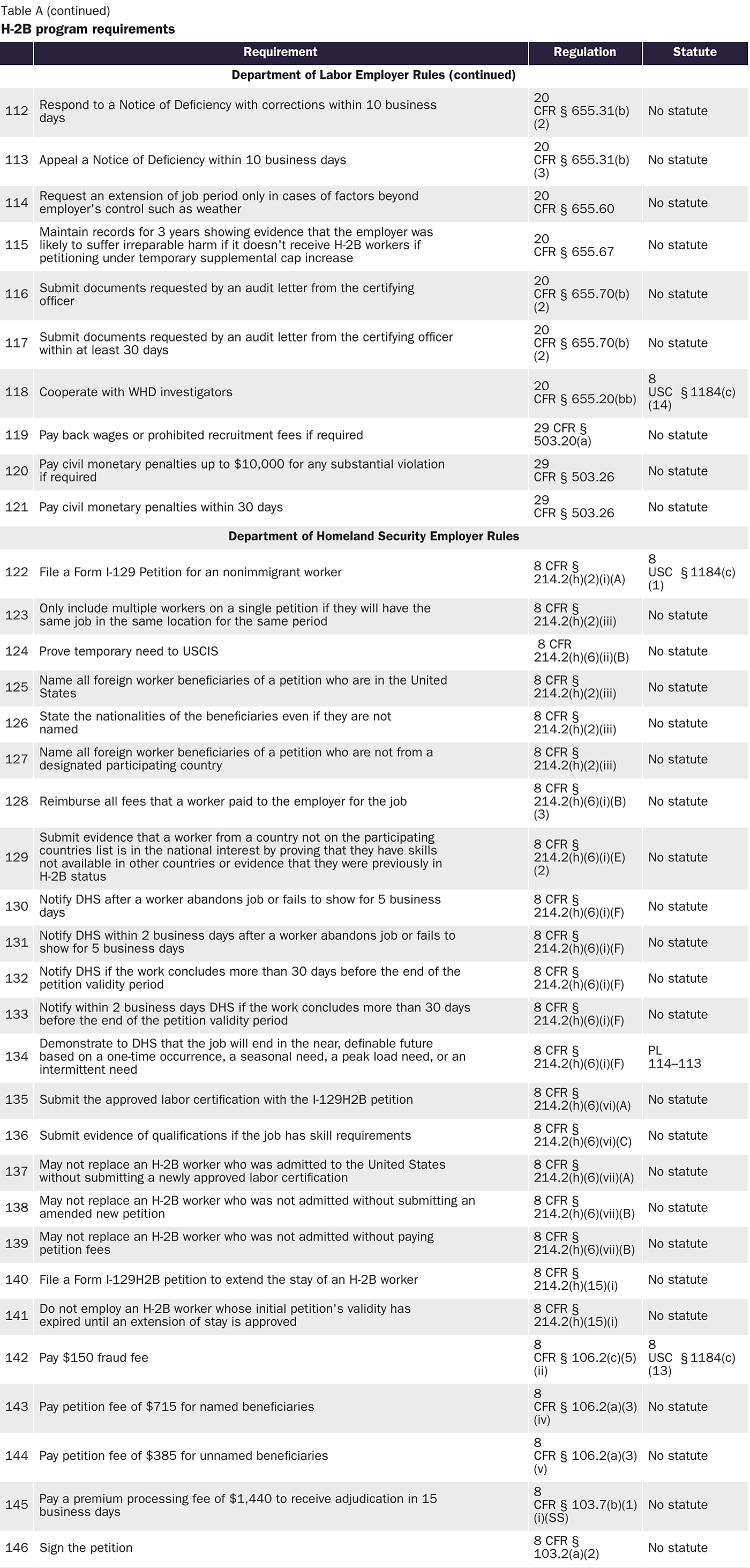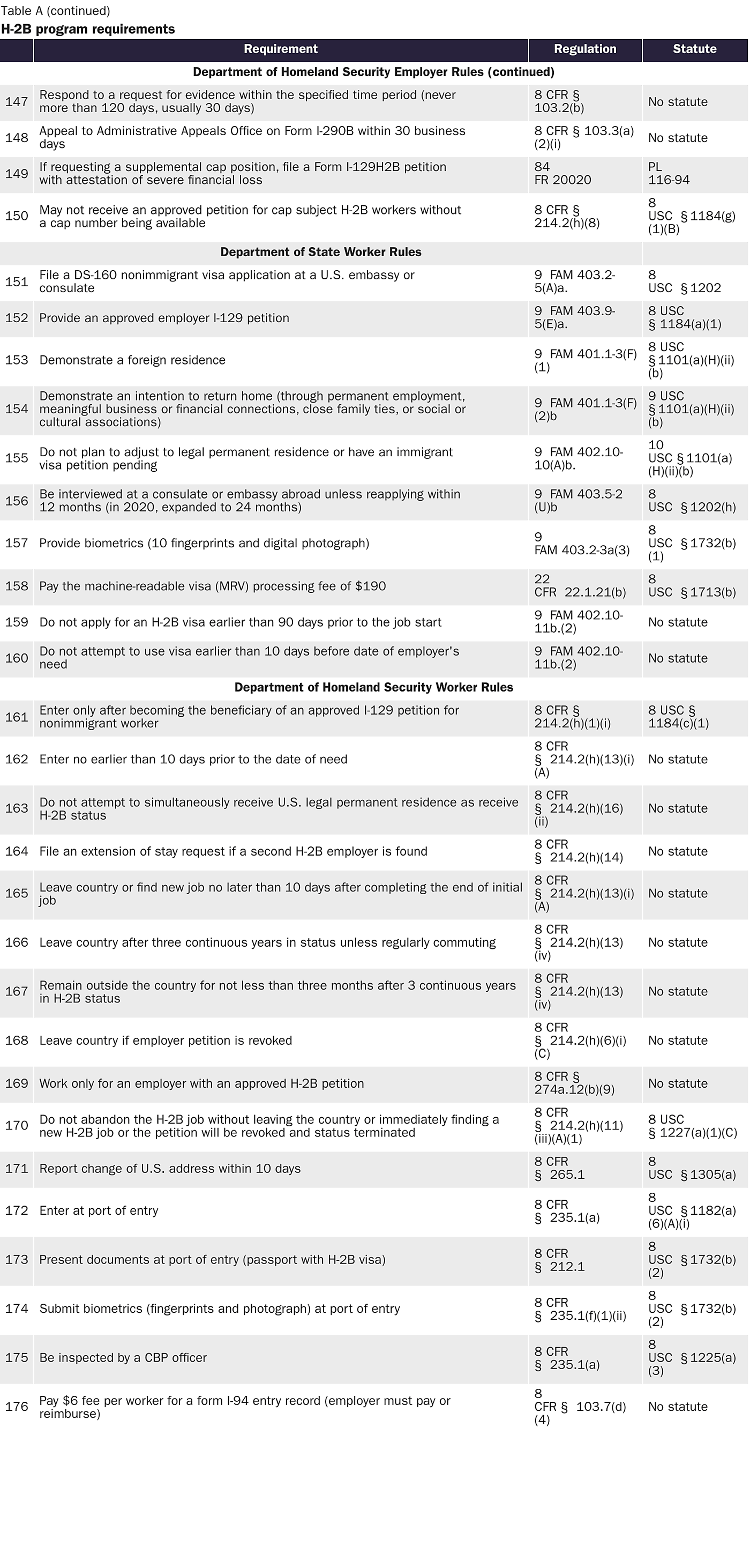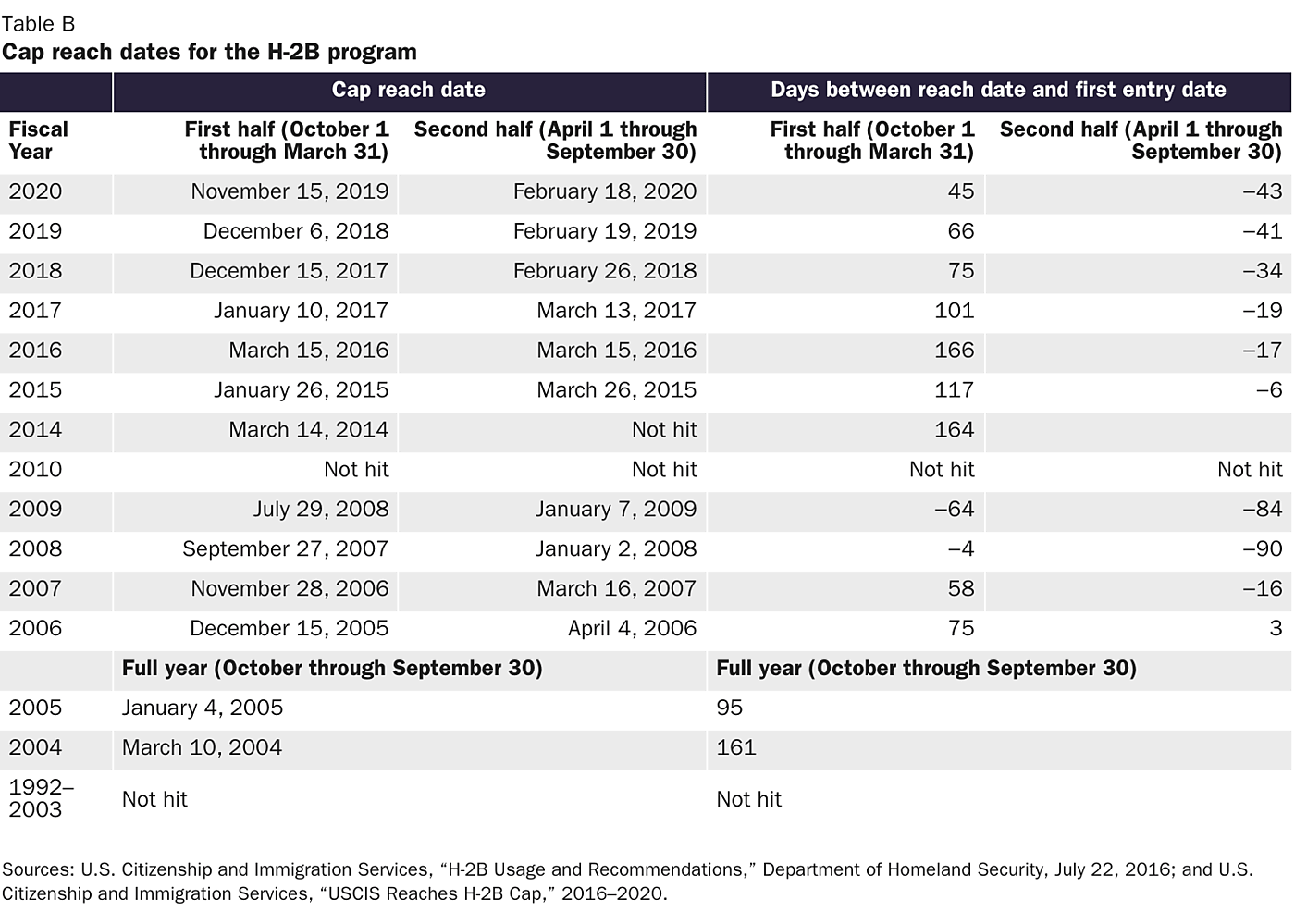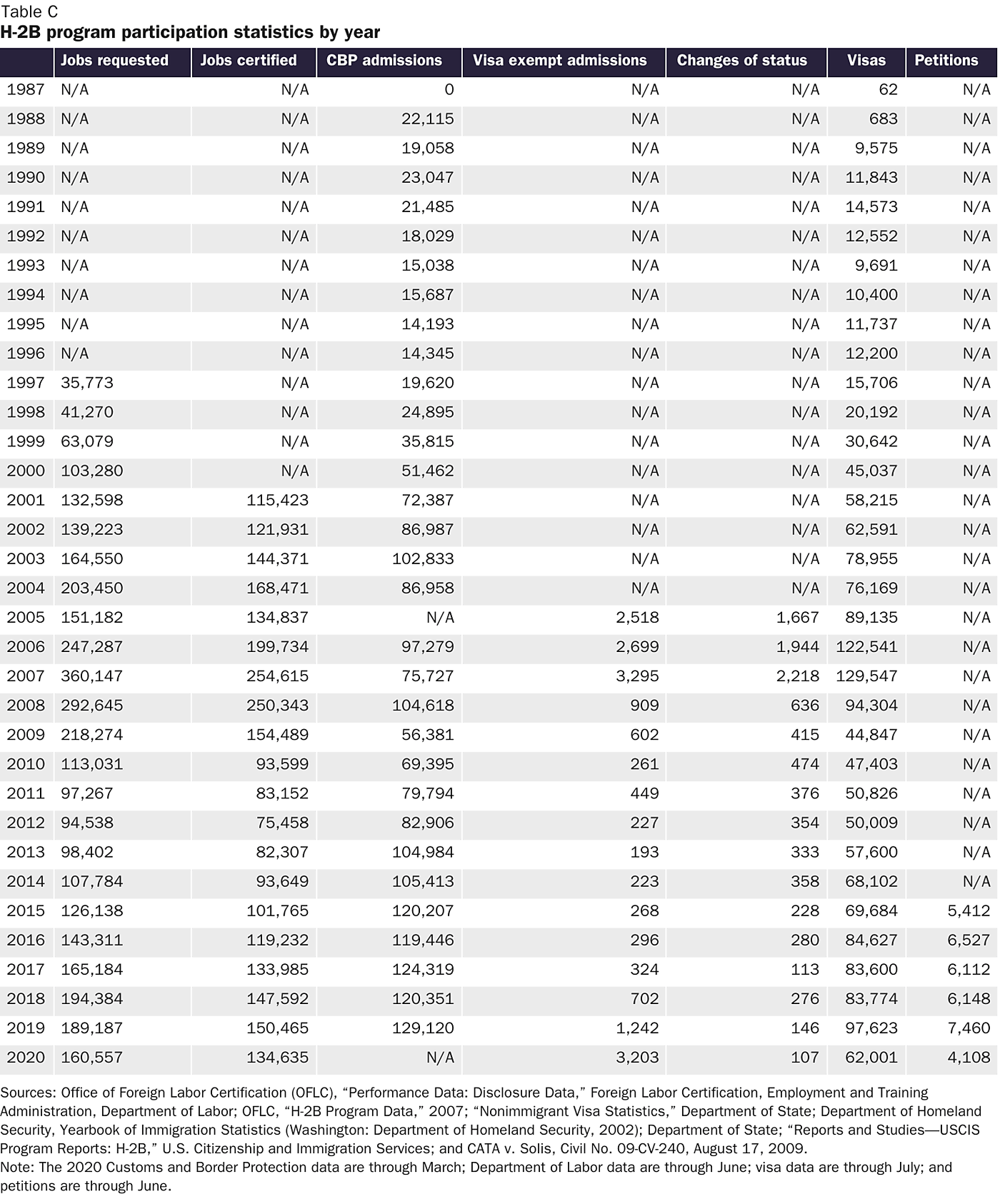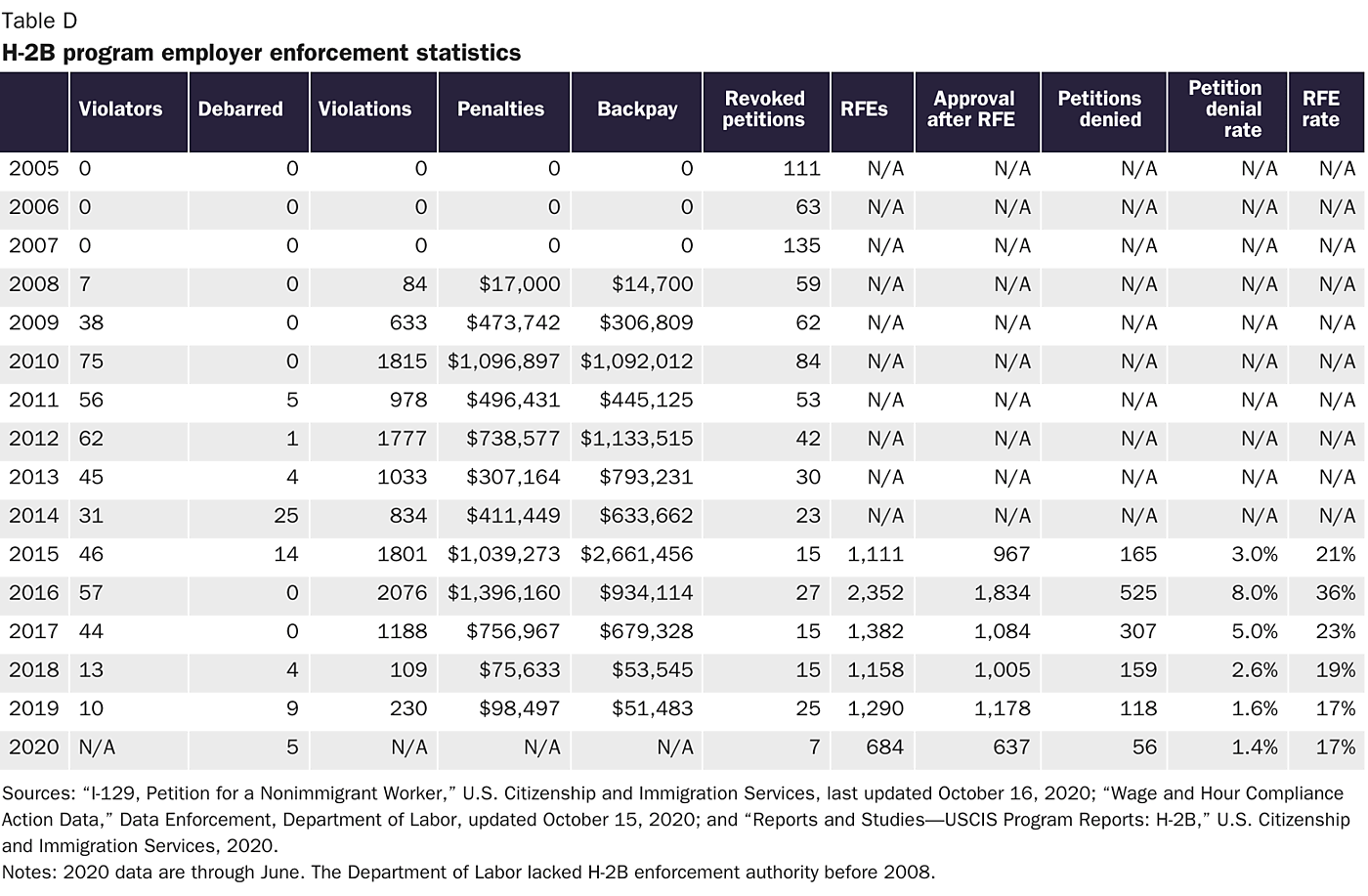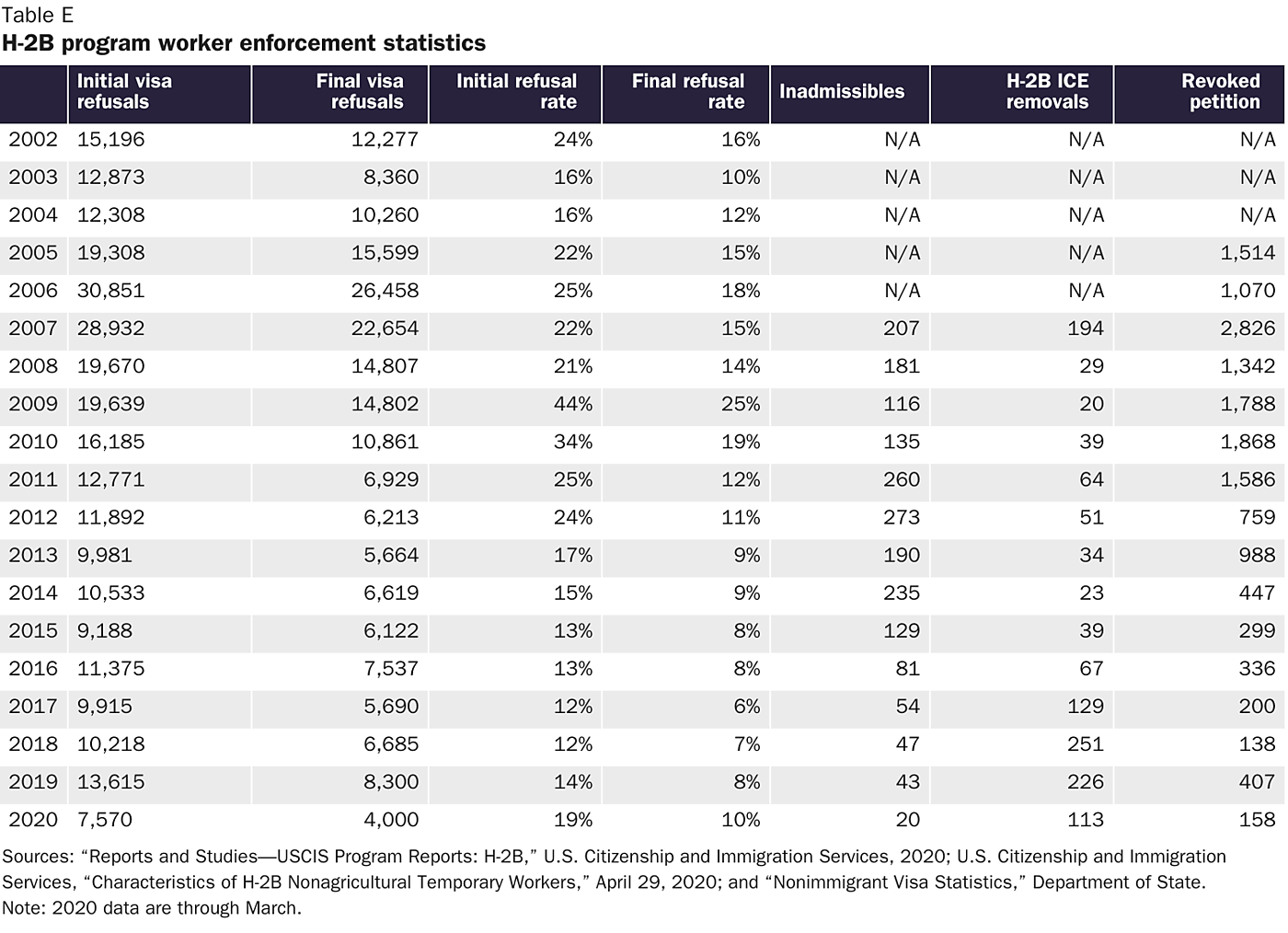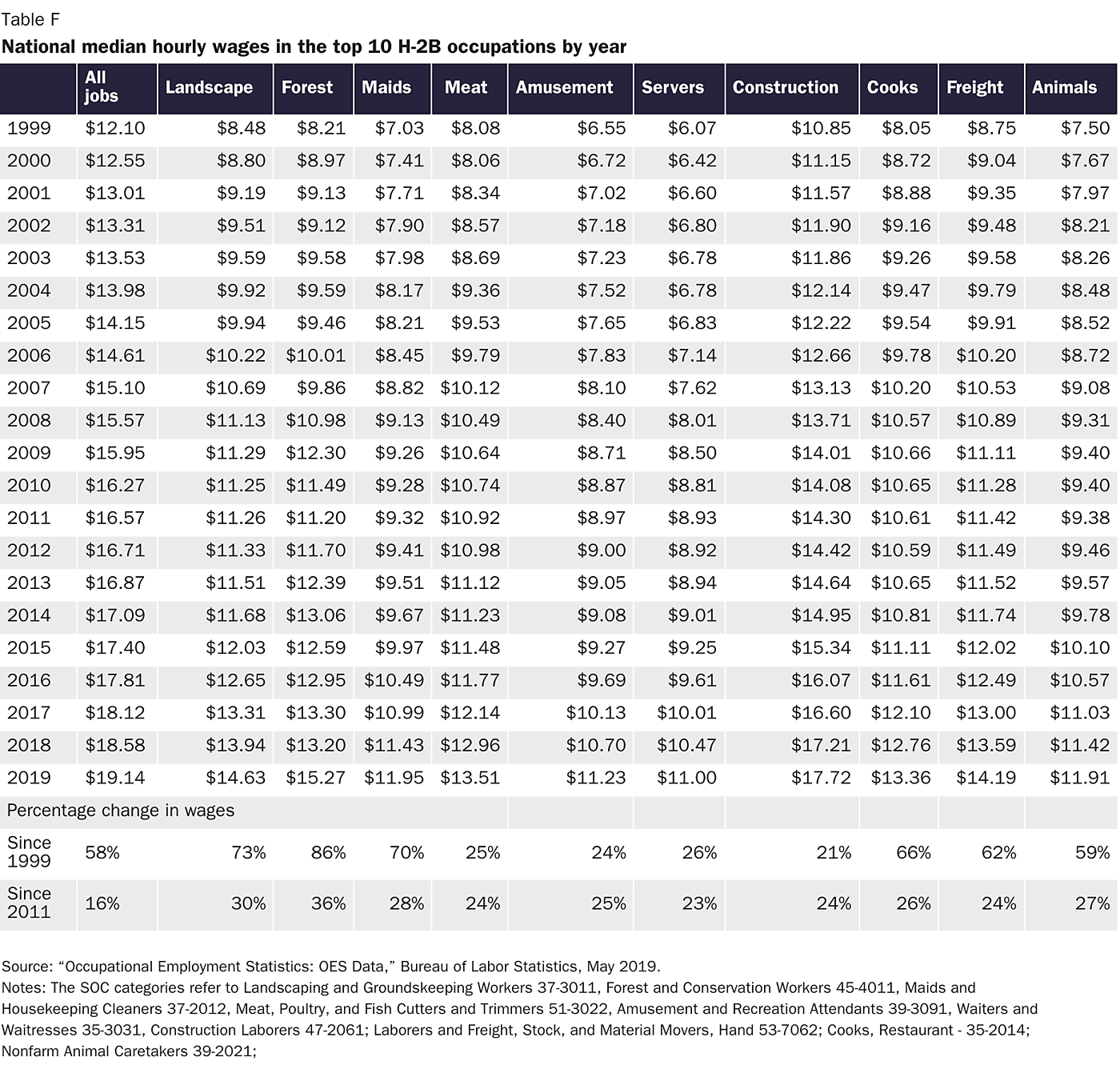1 8 U.S.C. § 1101(a)(15)(H)(ii)(b) (2018), https://www.govinfo.gov/content/pkg/USCODE-2018-title8/html/USCODE-2018-title8-chap12-subchapI-sec1101.htm.
2 Proclamation No. 10052, “Suspension of Entry of Immigrants and Nonimmigrants Who Present a Risk to the United States Labor Market During the Economic Recovery Following the 2019 Novel Coronavirus Outbreak,” 85 Fed. Reg. 38263 (June 22, 2020); and Proclamation No. 10131, “Suspension of Entry of Immigrants and Nonimmigrants Who Continue To Present a Risk to the United States Labor Market During the Economic Recovery Following the 2019 Novel Coronavirus Outbreak,” 86 Fed. Reg. 417 (December 31, 2020).
3 8 U.S.C. § 1101(a)(15)(H)(ii)(b) (2018), https://www.govinfo.gov/content/pkg/USCODE-2018-title8/html/USCODE-2018-title8-chap12-subchapI-sec1101.htm.
4 Immigration and Nationality Act of 1952, Pub. L. No. 82–414, ch. 447, § 101(a)(15)(H) (June 27, 1952), https://www.govinfo.gov/content/pkg/STATUTE-66/pdf/STATUTE-66-Pg163.pdf; and Congressional Research Service, “Temporary Worker Programs: Background and Issues,” February 1980, p. 64, https://ufdc.ufl.edu/UF00087217/00001/68j.
5 Immigration Reform and Control Act of 1986, Pub. L. No. 99–603, § 301, 100 Stat. 3359, https://www.govinfo.gov/content/pkg/STATUTE-100/pdf/STATUTE-100-Pg3445.pdf; and 8 U.S.C. § 1101(a)(15)(H)(ii)(a)-(b) (2018).
6 8 U.S.C. § 1101(a)(15)(H)(ii)(b) (2018); and 76 Fed. Reg. 3461 (January 19, 2011), https://www.govinfo.gov/content/pkg/FR-2011–01-19/pdf/2011–1117.pdf; as an example of a high skilled position, the Department of Labor certified four zoologists and wildlife biologists under the H‑2B program in 2019—see Office of Foreign Labor Certification, “Performance Data,” Foreign Labor Certification, Employment and Training Administration, Department of Labor, https://www.dol.gov/agencies/eta/foreign-labor/performance.
7 Proclamation No. 10014 § 2(b), 85 Fed. Reg. 23441 (April 22, 2020), https://www.govinfo.gov/content/pkg/FR-2020–04-27/pdf/2020–09068.pdf; and Department of State, “National Interest Exceptions to Presidential Proclamations (10014 & 10052) Suspending the Entry of Immigrants and Nonimmigrants Presenting a Risk to the United States Labor Market during the Economic Recovery Following the 2019 Novel Coronavirus Outbreak,” August 12, 2020, https://travel.state.gov/content/travel/en/News/visas-news/exceptions-to-p-p-10014–10052-suspending-entry-of-immigrants-non-immigrants-presenting-risk-to-us-labor-market-during-economic-recovery.html.
8 73 Fed. Reg. 29942, 29944 (May 22, 2008), https://www.govinfo.gov/content/pkg/FR-2008–05-22/pdf/E8-11214.pdf; and 80 Fed. Reg. 24042 (April 29, 2015), https://www.federalregister.gov/documents/2015/04/29/2015–09694/temporary-non-agricultural-employment-of-h-2b-aliens-in-the-united-states.
9 Office of the Citizenship and Immigration Services Ombudsman, Annual Report 2014 (Washington: Department of Homeland Security, June 27, 2014), https://www.dhs.gov/sites/default/files/publications/cisomb/cisomb_2014-annual-report-to-congress.pdf.
10 “Myths vs Facts,” Seasonal Employment Alliance, 2019, https://sealabor.com/myths-vs-facts.
11 20 C.F.R. § 655.1(a) (2018), https://www.law.cornell.edu/cfr/text/20/655.1.
12 Employment and Training Administration, “Filing Tips and Best Practices for H‑2B Labor Certification Applications,” Department of Labor, October 25, 2017, https://www.dol.gov/sites/dolgov/files/ETA/oflc/pdfs/H‑2B_Stakeholder_Webinar_10-2017.pdf.
13 Using the hourly rates removes outlier annual wages and makes for an easier comparison across years. Office of Foreign Labor Certification, “Performance Data.”
14 David J. Bier, “H‑2B Guest Worker Wages Exceed Every State Minimum, 60% Higher on Average,” Cato at Liberty (blog), Cato Institute, February 12, 2020.
15 20 C.F.R. § 655.10(b); private wage surveys are authorized under Consolidated Appropriations Act of 2016, Pub. L. 114–113, 129 Stat. 2599 §112 (December 18, 2015) https://www.congress.gov/114/plaws/publ113/PLAW-114publ113.pdf; and Office of Foreign Labor Certification, “Performance Data.”
16 20 C.F.R. § 655.731(a)(2)(ii) (2018). The DOL has commented that in the H‑2B program, “oversight at the Federal level is essential to ensuring that the job opportunities are advertised and paid at the required wage and therefore does not adversely affect U.S. worker wages,” but has not offered an explanation for why this is not the case for the H‑1B program. 73 Fed. Reg. 78020, 78028 (December 19, 2008), https://www.govinfo.gov/content/pkg/FR-2008–12-19/pdf/E8-29995.pdf.
17 20 C.F.R. § 655.10(b)(2) (2018); and 80 Fed. Reg. 24146, 24159 (April 29, 2015), https://www.govinfo.gov/content/pkg/FR-2015–04-29/pdf/2015–09692.pdf.
18 David J. Bier, “100% of H‑1B Employers Offer Average Market Wages—78% Offer More,” Cato at Liberty (blog), Cato Institute, May 18, 2020.
19 20 C.F.R. § 655.10(d) (2018), https://www.law.cornell.edu/cfr/text/20/655.10.
20 20 C.F.R. § 655.5 (2018).
21 20 C.F.R. § 655.10(b)(2) (2018), https://www.law.cornell.edu/cfr/text/20/655.10; and 78 Fed. Reg. 24047, 24052 (April 24, 2013), https://www.govinfo.gov/content/pkg/FR-2013–04-24/pdf/2013–09723.pdf.
22 78 Fed. Reg. 24047, 24053 (April 24, 2013); and 20 C.F.R. § 656.40(d)(1) (2018).
23 78 Fed. Reg. 24047, 24051 (April 24, 2013), https://www.govinfo.gov/content/pkg/FR-2013–04-24/pdf/2013–09723.pdf; an October 2020 proposed regulation would alter how the skill levels are created under the H‑1B program—see Office of Foreign Labor Certification, “Wage Library,” 2020, http://web.archive.org/web/20201006170635/https://www.flcdatacenter.com/OesQuickResults.aspx; and the Department of Labor changed how it calculates the entry level prevailing wage in October 2020—see 85 Fed. Reg. 63872 (October 8, 2020), https://www.govinfo.gov/content/pkg/FR-2020–10-08/pdf/2020–22132.pdf.
24 “Occupational Employment Statistics, May 2019: 47–2051 Cement Masons and Concrete Finishers,” Occupational Employment Statistics, Bureau of Labor Statistics, modified July 6, 2020, https://www.bls.gov/oes/current/oes472051.htm.
25 20 C.F.R. § 655.15(e) (2018).
26 20 C.F.R. § 655.15(f) (2018); Employment and Training Administration, “Training and Employment Guidance Letter No. 27–06,” Department of Labor, June 12, 2007, http://web.archive.org/web/20170711205030/https://wdr.doleta.gov/directives/corr_doc.cfm?DOCN=2446; and Employment and Training Administration, “Training and Employment Guidance Letter No. 31–05,” May 31, 2006, http://web.archive.org/web/20170711205017/https://wdr.doleta.gov/directives/corr_doc.cfm?DOCN=2228.
27 Many states allow employer to preload a job order to post on a certain date, so this may effectively be prepared before the 90-day limit in the law. 20 C.F.R. § 655.16(a)(1) (2018); and “About NASWA,” National Association of State Workforce Agencies.
28 20 C.F.R. § 655.16(b) (2018).
29 20 C.F.R. § 655.20(d); and 20 C.F.R. § 655.5 (2018). A 2008 regulation had defined full-time to mean 30 hours or more per week—see 73 Fed. Reg. 78020, 78054 (December 19, 2008), https://www.govinfo.gov/content/pkg/FR-2008–12-19/pdf/E8-29995.pdf.
30 20 C.F.R. § 655.15(b) (2018); and 8 C.F.R. 214.2(h)(6)(ii)(B) (2018).
31 8 C.F.R. 214.2(h)(6)(ii)(B) (2018); and note that 20 C.F.R. § 655.6(b) (2018) contains a nine-month restriction that Congress has barred—see Further Consolidated Appropriations Act of 2020, Pub. L. 116–94 (December 20, 2019), https://www.congress.gov/116/plaws/publ94/PLAW-116publ94.pdf.
32 8 C.F.R. § 214.2(h)(6)(iv)(B): “The Secretary of Labor may issue a temporary labor certification for a period of up to one year”; and 20 C.F.R. § 655.103(d) (2019).
33 Office of Foreign Labor Certification, “Performance Data.”
34 20 C.F.R. § 655.33(b) (2018).
35 20 C.F.R. § 655.40; and 20 C.F.R. § 655.43 (2018).
36 20 C.F.R. § 655.40(c) (2018).
37 H‑2B Workforce Coalition, “RE: RIN 1205-AB58 – Temporary Non-Agricultural Employment of H‑2B Aliens in the United States,” May 17, 2011, https://web.archive.org/web/20200911171451/https://cdn.ymaws.com/www.oan.org/resource/resmgr/imported/pdf/gr/NPRM_RIN-1205-AB58_H2B_Policies.pdf.
38 For example: Texas Labor Code § 207.047 (effective Sept. 1, 1993), https://texas.public.law/statutes/tex._labor_code_section_207.047.
39 “Employment Situation News Release,” Bureau of Labor Statistics, June 3, 2011, https://www.bls.gov/news.release/archives/empsit_06032011.htm; and ImmigrationWorksUSA, “Responses to IW H‑2B Survey,” April–May 2011, https://www.immigrationworksusa.org/uploaded/Responses%20to%20IW%20H-2B%20Survey.pdf.
40 Office of Advocacy, “Letter Dated 10/27/10—Department of Labor, Employment and Training Administration,” Small Business Administration, October 27, 2010, https://www.sba.gov/content/letter-dated-102710-department-labor-employment-and-training-administration‑1.
41 20 C.F.R. § 655.20(p) (2018); Employment and Training Administration, “Notice of Acceptance: H‑2B Temporary Non-Agricultural Program,” Department of Labor, July 7, 2020, https://www.cato.org/sites/cato.org/files/2020–09/Notice%20of%20Acceptance%20July%207%202020.PNG.
42 20 C.F.R. § 655.45(b) (2018); and 20 C.F.R. § 655.48(a) (2018).
43 Office of Foreign Labor Certification, “H‑2B Temporary Non-Agricultural Program—Selected Statistics, Fiscal Year (FY) 2020 Q1–Q3,” Employment and Training Administration, Department of Labor, 2020, https://www.dol.gov/sites/dolgov/files/ETA/oflc/pdfs/H‑2B_Selected_Statistics_FY2020_Q3.pdf.
44 77 Fed. Reg. 59670 (September 28, 2012), https://www.govinfo.gov/content/pkg/FR-2012–09-28/pdf/2012–23884.pdf; and 80 Fed. Reg. 24042, 24043 (April 29, 2015), https://www.govinfo.gov/content/pkg/FR-2015–04-29/pdf/2015–09694.pdf.
45 Office of Foreign Labor Certification, “H‑2B Temporary Non-Agricultural Program.”
46 Department of Labor Office of Inspector General, “ETA’s Lack of Key Controls over the H‑2B Application Process Jeopardized Businesses That Depend on H‑2B Workers,” Report no. 06–18-002–03-321, September 28, 2018, https://www.oig.dol.gov/public/reports/oa/2018/06–18-002–03-321.pdf.
47 Immigration Act of 1990, Pub. L. 101–649, 104 Stat. 4979 § 205 and § 231 (November 29, 1990), https://www.govinfo.gov/content/pkg/STATUTE-104/pdf/STATUTE-104-Pg4978.pdf.
48 8 U.S.C. § 1184(g)(10) (2018); Save Our Small and Seasonal Businesses Act of 2005, Pub. L. 109–13, 119 Stat. 318 (May 11, 2005), https://www.govinfo.gov/content/pkg/PLAW-109publ13/pdf/PLAW-109publ13.pdf.
49 20 C.F.R. § 655.15(b) (2018).
50 83 Fed. Reg. 3189, 3190 (January 23, 2018), https://www.govinfo.gov/content/pkg/FR-2018–01-23/pdf/2018–01166.pdf.
51 Office of Foreign Labor Certification, “U.S. Department of Labor Announces Updates to the H‑2B Temporary Labor Certification Program,” Department of Labor, February 26, 2019, https://www.dol.gov/sites/dolgov/files/ETA/oflc/pdfs/OFLC_Procedural-Change_H-2B_Application-Assignment_02.26.19.pdf; and 84 Fed. Reg. 7399 (March 4, 2019), https://www.govinfo.gov/content/pkg/FR-2019–03-04/pdf/2019–03809.pdf.
52 Office of Foreign Labor Certification, “H‑2B Non-Agricultural Visa Program—Selected Statistics, FY 2012 YTD,” Employment and Training Administration, Department of Labor, September 16, 2012, https://web.archive.org/web/20130205020029/http:/www.foreignlaborcert.doleta.gov/pdf/h_2b_temp_non_agricultural_visa.pdf; and Office of Foreign Labor Certification, “H‑2BTemporary Non-Agricultural Labor Certification Program—Selected Statistics, FY 2019 EOY,” September 30, 2019, https://www.dol.gov/sites/dolgov/files/ETA/oflc/pdfs/H‑2B_Selected_Statistics_FY2019_Q4.pdf.
53 20 C.F.R. § 655.40(c) (2018); and 20 C.F.R. § 655.52 (2018).
54 8 C.F.R. § 214.2(h)(8)(vii) (2018).
55 8 U.S.C. § 1184(g)(1)(B) (2018).
56 48 U.S.C. § 1806(a)(2) as amended by Northern Mariana Islands U.S. Workforce Act of 2018, Pub. L. 115–218, 132 Stat. 1547 § 3 (July 25, 2018); 48 U.S.C. § 1806(b); and Department of Defense Appropriations Act of 2005, Pub. L. 108–287, 118 Stat. 1014 § 14006 (August 5, 2004), https://www.congress.gov/108/plaws/publ287/PLAW-108publ287.pdf; and 354 jobs were certified in roe occupations in 2019—see Office of Foreign Labor Certification, “Performance Data.”
57 8 C.F.R. § 214.2(h)(8)(vii) (2018).
58 “Some employers stated that they would prefer that DHS use a more equitable method to award and distribute visas, such as giving every employer a proportion of the visas they petition for.” Government Accountability Office, “H‑2B Visas: Additional Steps Needed to Meet Employers’ Hiring Needs and Protect U.S. Workers,” GAO-20–230, April 2020, https://www.gao.gov/assets/710/705639.pdf.
59 8 C.F.R. § 214.2(h)(8)(vii) (2018).
60 Since the cap applies only to workers who actually receive visas or status—a later stage in the process—USCIS must estimate how many petitions it must approve to fill the cap. It generally approves petitions for between 20 and 25 percent more workers than the cap permits because some workers are denied visas or status, and some employers hire fewer workers than they requested. The agency has twice miscalculated how many petitions were needed (in 2009 and 2015) and reopened the cap to allow more petitions later in the year. U.S. Citizenship and Immigration Services, “H‑2B Usage and Recommendations,” Department of Homeland Security, July 22, 2016, https://www.dhs.gov/sites/default/files/publications/U.S.%20Citizenship%20and%20Immigration%20Services%20-%20H-2B%20Usage%20and%20Recommendations.pdf.
61 Save Our Small and Seasonal Businesses Act of 2005, Pub. L. 109–13, 119 Stat. 318 (May 11, 2005); and John Warner National Defense Authorization Act for Fiscal Year 2007, Pub. L. 109–364, 120 Stat. 2095 § 1074 (October 17, 2006), https://www.congress.gov/109/plaws/publ364/PLAW-109publ364.htm. In 2008, employers submitted nearly as many job requests because they expected another “returning worker” exemption, but members of Congress wanting to force a vote on comprehensive immigration reform objected and managed to stop the extension. David Holthouse, “Visa Fight Leaves Businesses Short Summer Workers,” CNN, April 18, 2008, https://money.cnn.com/2008/04/16/smbusiness/h2b_visas.fsb/index.htm?postversion=2008041810.
62 Consolidated Appropriations Act of 2016, Pub. L. 114–113, 129 Stat. 2523 §565 (December 18, 2015), https://www.govinfo.gov/content/pkg/PLAW-114publ113/pdf/PLAW-114publ113.pdf; “Nonimmigrant Visa Statistics,” U.S. Visa Law and Policy, Bureau of Consular Affairs, Department of State, https://travel.state.gov/content/travel/en/legal/visa-law0/visa-statistics/nonimmigrant-visa-statistics.html.
63 Consolidated Appropriations Act of 2017, Pub. L. 115–31, 131 Stat. 432 § 543 (May 5, 2017), https://www.congress.gov/115/plaws/publ31/PLAW-115publ31.pdf; 82 Fed. Reg. 32987, 32988 (July 19, 2017), https://www.federalregister.gov/documents/2017/07/19/2017–15208/exercise-of-time-limited-authority-to-increase-the-fiscal-year-2017-numerical-limitation-for-the.
64 Consolidated Appropriations Act of 2018, Pub. L. 115–141, 132 Stat. 1049 § 205 (March 23, 2018), https://www.congress.gov/115/plaws/publ141/PLAW-115publ141.pdf; Consolidated Appropriations Act of 2019, Pub. L. 116–6, 133 Stat. 475 § 105 (February 15, 2019), https://www.congress.gov/116/plaws/publ6/PLAW-116publ6.pdf; Further Consolidated Appropriations Act of 2020, Pub. L. 116–94, 133 Stat. 3019 § 105 (December 20, 2019), https://www.congress.gov/116/plaws/publ94/PLAW-116publ94.pdf; 82 Fed. Reg. 32987 (July 19, 2017), https://www.govinfo.gov/content/pkg/FR-2017–07-19/pdf/2017–15208.pdf; 83 Fed. Reg. 24905 (May 31, 2018), https://www.govinfo.gov/content/pkg/FR-2018–05-31/pdf/2018–11732.pdf; and 84 Fed. Reg. 20005, 20009 (May 8, 2019), https://www.govinfo.gov/content/pkg/FR-2019–05-08/pdf/2019–09500.pdf.
65 Suzanne Monyak, “DHS Halts Extra Guestworker Visas as Unemployment Jumps,” Law360, April 2, 2020, https://www.law360.com/articles/1259875/dhs-halts-extra-guestworker-visas-as-unemployment-jumps.
66 David J. Bier, “The Murky Origins of the H‑2B Program’s Prevailing Wage Rule,” Cato at Liberty (blog), Cato Institute, July 23, 2020; and U.S. Citizenship and Immigration Services, “H‑2B Usage and Recommendations.”
67 Save Our Small and Seasonal Businesses Act of 2005, Pub. L. 109–13, 119 Stat. 318 (May 11, 2005); and John Warner National Defense Authorization Act for Fiscal Year 2007, Pub. L. 109–364, 120 Stat. 2370 § 1074, https://www.congress.gov/109/plaws/publ364/PLAW-109publ364.htm.
68 U.S. Citizenship and Immigration Services, “Characteristics of H‑2B Nonagricultural Temporary Workers,” Department of Homeland Security, April 29, 2020, https://www.uscis.gov/sites/default/files/document/data/FY_2019_H-2B_Characteristics_Report_Signed_Dated_4.29.20.pdf.
69 In 2020, DHS finalized a rule to lower the fee for named workers, but a court has blocked implementation of the fee increase, and the Biden administration has announced that it will not implement the rule. 85 Fed. Reg. 46788, 46791 (August 3, 2020), https://www.govinfo.gov/content/pkg/FR-2020–08–03/pdf/2020–16389.pdf. 86 Fed. Reg. 7493 (January 29, 2021), https://www.govinfo.gov/content/pkg/FR-2021–01-29/pdf/2021–02044.pdf.
70 In 2020, DHS finalized a rule to increase the fee for named workers and limit the number of named workers on a petition, but a court has blocked implementation of the fee increase, and the Biden administration has announced that it will not implement the rules. 85 Fed. Reg. 46788, 46862 (August 3, 2020), https://www.govinfo.gov/content/pkg/FR-2020–08–03/pdf/2020–16389.pdf. 86 Fed. Reg. 7493 (January 29, 2021), https://www.govinfo.gov/content/pkg/FR-2021–01-29/pdf/2021–02044.pdf.
71 Continuing Appropriations Act, 2021 and Other Extensions Act, Pub. L. 116–159, 134 Stat. 709, (October 1, 2020), https://www.congress.gov/116/plaws/publ159/PLAW-116publ159.pdf.
72 U.S. Citizenship and Immigration Services, “I‑129—Petition for a Nonimmigrant Worker Specialty Occupations (H‑1B) by Fiscal Year, Month, and Case Status: October 1, 2014–June 30, 2020,” August 18, 2020, https://www.uscis.gov/sites/default/files/document/data/I129_Quarterly_Request_for_Evidence_FY2015_FY2020_Q3.pdf.
73 8 C.F.R. § 214.2(h)(6)(ii)(B) (2018).
74 Office of the Citizenship and Immigration Services Ombudsman, Annual Report 2015 (Washington: Department of Homeland Security, June 29, 2015), https://www.dhs.gov/sites/default/files/publications/cisomb/cisomb_2015-annual-report-to-congress.pdf; and Office of the Citizenship and Immigration Services Ombudsman, Annual Report 2016 (Washington: Department of Homeland Security, June 29, 2016), https://www.dhs.gov/sites/default/files/publications/cisomb/cisomb_2016-annual-report-to-congress.pdf.
75 U.S. Citizenship and Immigration Services, “I‑129—Petition for a Nonimmigrant Worker.”
76 Canadian and Bermudan citizens, Bahamian nationals, and British subjects resident in certain Caribbean islands. All H‑2B visa exempt admissions are from Canada and have risen more than tenfold from 296 in 2016 to 3,203 in the first half of 2020. 8 C.F.R. § 212.1(a)-(b); U.S. Citizenship and Immigration Services, “H‑2B Nonagricultural Temporary Worker Visa and Status,” September 14, 2020, https://www.uscis.gov/sites/default/files/document/reports/H‑2B_FY20_Semiannual_Report_to_Congress_Part_1.pdf; and U.S. Citizenship and Immigration Services, “Characteristics of H‑2B Nonagricultural Temporary Workers,” July 14, 2017, https://www.uscis.gov/sites/default/files/document/data/h‑2b-fy2016-characteristics-report.pdf.
77 “Workers must prove that at least two of the following criteria apply: The applicant was previously employed and trained by the petitioning U.S. employer. The applicant must have previously worked for the petitioning U.S. employer under two or more H‑2B (named or unnamed) petitions. U.S. employers dedicate substantial time and resources to training seasonal/temporary staff, and denying visas to the most experienced returning workers may cause financial hardship to the U.S. business. The applicant is traveling based on a temporary labor certification that reflects continued need for the worker. TLCs approved by DOL during or after July 2020 are more likely to account for the effects of the COVID-19 pandemic on the U.S. labor market and the petitioner’s business, and therefore this indicator is only present for cases with a TLC approved during or after July 2020 as there is an indication that the petitioner still has a need for the H‑2B worker. For TLCs approved by DOL before July 2020, this indicator is only met if the consular officer can determine from the visa application the continuing need of petitioned workers with the U.S. employer. Denial of the visa pursuant to P.P. 10052 will cause financial hardship to the U.S. employer. The following examples, to be assessed based on information from the visa application, are illustrative of what may constitute a financial hardship for an employer if a visa is denied: the employer’s inability to meet financial or contractual obligations; the employer’s inability to continue its business; or a delay or other impediment to the employer’s ability to return to its pre-COVID-19 level of operations.” Proclamation No. 10014 § 2(b), 85 Fed. Reg. 23441 (April 22, 2020); and Department of State, “National Interest Exceptions to Presidential Proclamations (10014 & 10052).”
78 22 C.F.R. § 22.1.21(b) (2018); and 20 C.F.R. § 655.20(j)(2) (2018).
79 “Expansion of Interview Waiver Eligibility,” U.S. Visas, Bureau of Consular Affairs, Department of State, August 25, 2020, https://travel.state.gov/content/travel/en/News/visas-news/expansion-of-interview-waiver-eligibility.html.
80 22 C.F.R. § 41.53(c) (2018).
81 U.S. Citizenship and Immigration Services, “Characteristics of H‑2B Nonagricultural Temporary Workers,” April 29, 2020.
82 “Reasons for a visa refusal typically include matters outside of the scope of USCIS petition adjudication, such as determinations of inadmissibility, findings of immigrant intent under section 214(b) of the INA, or findings that the petitioning employer or an agent, facilitator, recruiter, or similar employment service required the prospective H‑2B worker to pay a prohibited fee at any time as a condition of employment.” U.S. Citizenship and Immigration Services, “Characteristics of H‑2B Nonagricultural Temporary Workers,” April 29, 2020.
83 Department of State, “Residence Abroad Defined,” 9 FAM 401.1–3(F)(2) (October 20, 2016), https://fam.state.gov/fam/09FAM/09FAM040101.html.
84 Office of the Citizenship and Immigration Services Ombudsman, Annual Report 2012 (Washington: Department of Homeland Security, June 25, 2012), https://www.dhs.gov/sites/default/files/publications/cisomb-2012-annualreport.pdf.
85 Office of the Citizenship and Immigration Services Ombudsman, Annual Report 2014.
86 “While the agencies do not collect information on the extent to which workers arrive by the date employers state that they are needed, a few employers told us that their workers did not arrive on time.” Government Accountability Office, “H‑2A Visa Program: Modernization and Improved Guidance Could Reduce Employer Application Burden,” GAO-12–706, September 2012, https://www.gao.gov/assets/650/648175.pdf.
87 8 C.F.R. § 214.2(h)(13)(i)(A) (2018), https://www.law.cornell.edu/cfr/text/8/214.2.
88 8 U.S.C. § 1184(g)(1)(B) (2018). International students, by contrast, retain their status or right to hold status continuously over the course of their studies, despite regular school breaks—see 8 C.F.R. § 214.2(f)(5)(i) (2018).
89 Customs and Border Protection, “CBP Reminds Travelers to Obtain the I‑94 Permit Early,” news release, March 11, 2013; and Peter Samore, “Arizona’s Immigration Crisis: How Border Towns Are Impacted,” KTAR News, April 16, 2019, https://ktar.com/story/2527278/arizonas-immigration-crisis-how-border-towns-are-impacted/.
90 20 C.F.R. § 655.20(f) (2018).
91 Further Consolidated Appropriations Act of 2020, Pub. L. 116–94, 113 Stat. 2554 § 111 (December 20, 2019), https://www.congress.gov/116/plaws/publ94/PLAW-116publ94.pdf; and FY2021 Omnibus and COVID Relief and Response Act, (December 27, 2020), https://www.congress.gov/bill/116th-congress/house-bill/133/text.
92 Wage and Hour Division, “Fact Sheet #78: General Requirements for Employers Participating in the H‑2B Program,” Department of Labor, April 2015, https://www.dol.gov/sites/dolgov/files/WHD/legacy/files/whdfs78.pdf.
93 Office of Advocacy, “Letter Dated 5/17/11—Department of Labor, Employment and Training Administration,” Small Business Administration, May 17, 2011, https://www.sba.gov/content/letter-dated-51711-department-labor-employment-and-training-administration‑1.
94 20 C.F.R. § 655.15(f) (2018); Employment and Training Administration, “Round 9: Staggered Crossing of H‑2B Nonimmigrants Working in the Seafood Industry,” Department of Labor, 2015, https://www.dol.gov/sites/dolgov/files/ETA/oflc/pdfs/H‑2B_2015_IFR_FAQs_Round9.pdf; and Outdoor Amusement Business Association, “Ensuring a Viable H‑2B Program,” 2013, https://www.oaba.org/page-18055.
95 20 C.F.R. § 655.122(i) (2018).
96 20 C.F.R. § 655.20(y) (2018).
97 “The proposed regulations state that the Certifying Officer (CO) can terminate the employer’s obligations under the guarantee in the event of fire, weather, or another act of God that makes the fulfillment of the job order impossible. Small businesses have stated that this safety valve will not be very helpful for small H‑2B employers. Employers would bear the burden of informing DOL in a timely manner of these events or they could be held liable for payment. Additionally, the only remedy for employers is to terminate the job order.” Office of Advocacy, “Letter Dated 5/17/11—Department of Labor, Employment and Training Administration,” Small Business Administration, May 17, 2011, https://www.sba.gov/content/letter-dated-51711-department-labor-employment-and-training-administration‑1.
98 There are two categories of exempt U.S. full-time, year-round employees. 20 C.F.R. § 655.5; and 77 Fed. Reg. 10038, 10046 (February 21, 2012), https://www.govinfo.gov/content/pkg/FR-2012–02-21/pdf/2012–3058.pdf. The Department of Labor noted, “Some [employers] stated that they could not afford to provide the same terms and conditions of employment to corresponding workers, including paying the prevailing wage and guaranteeing three-fourths of the hours. For example, a golf course association stated that it would be financially impossible to provide the same wages and benefits to summer high school and college laborers as it provided to H‑2B workers performing the same manual labor.”
99 “An employer will be forced to monitor its employees and ensure they remain within the confines of their job description.” H‑2B Workforce Coalition, “RE: RIN 1205-AB58—Temporary Non-Agricultural Employment of H‑2B Aliens in the United States,” May 17, 2011, https://cdn.ymaws.com/www.oan.org/resource/resmgr/imported/pdf/gr/NPRM_RIN-1205-AB58_H2B_Policies.pdf.
100 The Department of Labor has never issued a housing regulation specific to employers of mobile workers. It has stated that it will interpret its existing regulations to require this—see 80 Fed. Reg. 24042, 24063 (April 29, 2015); and Office of Foreign Labor Certification, “Round 15: Obligations and Job Order Content for Employers of a Mobile Workforce,” Department of Labor, 2015, https://www.dol.gov/sites/dolgov/files/ETA/oflc/pdfs/H‑2B_2015_IFR_FAQ_Job-Order-Content_Mobile-Occupations.pdf.
101 20 C.F.R. § 655.20(j) (2018).
102 20 C.F.R. § 655.56(b)–(d) (2018).
103 Office of Inspector General, “DOL Needs to Improve Debarment Processes to Ensure Foreign Labor Program Violators Are Held Accountable,” Department of Labor report no. 06–20-001–03-321, September 30, 2020, https://www.oig.dol.gov/public/reports/oa/2020/06–20-001–03-321.pdf.
104 20 C.F.R. § 655.70 (2018); and Government Accountability Office, “H‑2B Visas: Additional Steps Needed.”
105 Employment and Training Administration, “Round 10: Integrity Measures,” Department of Labor, 2015, https://www.dol.gov/sites/dolgov/files/ETA/oflc/pdfs/H‑2B_2015_IFR_FAQs_Round10.pdf.
106 Government Accountability Office, “H‑2B Visas: Additional Steps Needed.”
107 29 C.F.R. § 503.15 (2018); in 2020, the Wage and Hour Division had 1,382 employees, slightly more than in 2014, not including H‑1B-funded employees—see Wage and Hour Division, “FY 2021 Congressional Budget Justification,” Department of Labor, 2020, https://www.dol.gov/sites/dolgov/files/general/budget/2021/CBJ-2021-V2-09.pdf; and Wage and Hour Division, “FY 2014 Congressional Budget Justification,” Department of Labor, 2013, https://www.dol.gov/sites/dolgov/files/general/budget/2016/CBJ-2016-V2-09.pdf.
108 Epstein, Becker, Green, “Wage and Hour Division (WHD) Investigation Checklist,” 2015, https://www.ebglaw.com/content/uploads/2015/09/Wage-Hour-Division-WHD-Investigation-Checklist-Epstein-Becker-Green.pdf.
109 29 C.F.R. § 503.23 (2018).
110 29 C.F.R. § 503.24 (2018); and 29 C.F.R. § 503.20 (2018).
111 8 C.F.R. § 214.2(h)(13)(i)(A) (2018); and 8 C.F.R. § 214.2(h)(13)(iv) (2018).
112 8 C.F.R. § 214.2(h)(23)(iv) (2018).
113 80 Fed. Reg. 24042, 24091 (April 29, 2015), https://www.govinfo.gov/content/pkg/FR-2015–04-29/pdf/2015–09694.pdf.
114 This is slightly more than the number of certified jobs in 2019 (150,465). While this estimate is possible because H‑2B workers can have short 10-day gaps between jobs, the DHS estimate is probably higher than the reality given that H‑2B jobs often go unfilled as a result of the cap—a phenomenon that DOL fails to track.
115 Office of Foreign Labor Certification, Annual Report 2016 (Washington: Department of Labor, 2017), https://www.dol.gov/sites/dolgov/files/ETA/oflc/pdfs/OFLC_Annual_Report_FY2016.pdf.
116 Census Bureau, “2017 SUSB Annual Data Tables by Establishment Industry,” March 2020, https://www.census.gov/data/tables/2017/econ/susb/2017-susb-annual.html; Government Accountability Office, “H‑2B Visas: Additional Steps Needed”; and U.S. Citizenship and Immigration Services, “Approved H‑2B Cap-Subject Beneficiaries by Job Code, Fiscal Year 2017,” October 31, 2017, https://www.uscis.gov/sites/default/files/document/data/approved-h-2b-cap-subject-beneficiaries-by-job-code-fy-2017.pdf.
117 This accounts for overtime pay and the length of the job period. Office of Foreign Labor Certification, “Performance Data.”
118 The survey misses H‑2B workers who live in temporary housing. American Community Survey, 1‑Year Estimates—Public Use Microdata Sample, 2018, https://data.census.gov/mdat/#/search?ds=ACSPUMS1Y2018&cv=INDP&rv=OCCP&….
119 David J. Bier, “H‑2A Visas for Agriculture: The Complex Process for Farmers to Hire Agricultural Guest Workers,” Cato Institute Immigration Research and Policy Brief no. 17, March 10, 2017.
120 Construction employers may also have trouble proving the needs are temporary, guaranteeing certain employment lengths in advance, paying inflated H‑2B wages and immigration fees, limiting workers to a single job category or geographic area, and fulfilling the other demands of the H‑2B program. “Sector 23—Construction: May 2019 National Industry-Specific Occupational Employment and Wage Estimates,” Bureau of Labor Statistics, March 31, 2020, https://www.bls.gov/oes/current/oessrci.htm#23; Kim Slowey, “‘Truly No Better Option’: H‑2B Visas for Construction Workers Spark Industry Controversy,” Construction Dive, https://www.constructiondive.com/news/truly-no-better-option-h-2b-visas-for-construction-workers-spark-industr/421224/.
121 “U.S. Immigration Law in the Commonwealth of the Northern Mariana Islands (CNMI),” U.S. Citizenship and Immigration Services, updated June 18, 2020, https://www.uscis.gov/laws-and-policy/other-resources/us-immigration-law-in-the-commonwealth-of-the-northern-mariana-islands-cnmi.
122 Department of Defense Appropriations Act of 2005, Pub. L. 108–287, 118 Stat. 1014 § 14006 (August 5, 2004); and 354 jobs were certified in roe occupations in 2019—see Office of Foreign Labor Certification, “Performance Data.”
123 Office of Advocacy, “Letter Dated 10/27/10—Department of Labor, Employment and Training Administration,” Small Business Administration, October 27, 2010, https://www.sba.gov/content/letter-dated-102710-department-labor-employment-and-training-administration‑1.
124 Government Accountability Office, “H‑2B Visas: Additional Steps Needed.”
125 Adam Startin, “The 5 Hardest Things about Working a Tree Planting Job,” Tentree, October 22, 2017, https://www.tentree.com/blogs/posts/the-5-hardest-things-about-working-a-tree-planting-job.
126 “Forest and Conservation Workers,” Occupational Outlook Handbook, Bureau of Labor Statistics, September 1, 2020, https://www.bls.gov/ooh/farming-fishing-and-forestry/forest-and-conserv….
127 “Labor Force Statistics from the Current Population Survey,” Bureau of Labor Statistics, December 4, 2020, https://www.bls.gov/web/empsit/cpseea30.htm.
128 There were insufficient data for forest and conservation workers. Current Population Survey, Annual Social and Economic (March) Supplement, 2020, https://data.census.gov/mdat/#/search?ds=CPSASEC2019&vv=*A_WKSLK(1:999)….
129 In 2020, the unemployment rate did spike without any change in H‑2B demand, but that year, U.S. workers were told to remain home, and they received such significant increases unemployment benefits and cash relief from the government that U.S. median incomes rose even with many job losses. Combined with a stay-at-home COVID-19 message from the government, these payments may have undermined any motivation to apply for H‑2B jobs that the spike in unemployment would have otherwise created. Nancy Marshall Genzer, “Incomes Rose in April, But Only Because of Government Relief Payments,” Marketplace, May 29, 2020.
130 Government Accountability Office, “H‑2B Visas: Additional Steps Needed.”
131 Madeline Zavodny, “Immigration and American Jobs,” American Enterprise Institute for Public Policy Research and Partnership for a New American Economy, December 2011, https://www.newamericaneconomy.org/sites/all/themes/pnae/img/NAE_Im-AmerJobs.pdf; Madeline Zavodny and Tamar Jacoby, “The Economic Impact of H‑2B Workers,” ImmigrationWorks USA and Labor, Immigration and Employee Benefits Division, U.S. Chamber of Commerce, October 28, 2010, https://www.uschamber.com/sites/default/files/documents/files/16102_LABR%2520H2BReport_LR.pdf; Douglas W. Lipton, “An Economic Analysis of Guest Workers in Maryland’s Blue Crab Industry,” University of Maryland, 2008, https://www.mdseagrant.org/store/index.php?publication=UM-SG-SGEP-2008–01; and Thomas J. Murray, “Preliminary Analysis of the Economic Impact of the H‑2B Worker Program on Virginia’s Economy,” Virginia Institute of Marine Science Marine Resource report no. 2011-12, September 2011, http://web.vims.edu/GreyLit/VIMS/mrr11-12.pdf.
132 Office of Foreign Labor Certification, “Performance Data.”
133 More agents working can mean more apprehensions without more total border crossings. Comparing apprehensions to admissions is more methodologically sound than comparing apprehensions to H‑2 visas or H‑2 jobs because the same worker can be admitted multiple times or apprehended multiple times. Immigration and Naturalization Service, Yearbook of Immigration Statistics (Washington: Department of Justice, 1992); Department of Homeland Security, Yearbook of Immigration Statistics (Washington: Department of Homeland Security, 2019); “CBP: Enforcement Statistics FY 2019: Total CBP Enforcement Actions,” Customs and Border Protection, https://www.cbp.gov/newsroom/stats/cbp-enforcement-statistics-fy2019; Border Patrol, “Nationwide Illegal Alien Apprehensions Fiscal Years 1925–2018,” Customs and Border Protection, Department of Homeland Security; Border Patrol, “Border Patrol Agent Nationwide Staffing by Fiscal Year,” Customs and Border Protection, Department of Homeland Security, March 2019; and “Border Patrol Agents: Southern versus Northern Border,” Transactional Records Access Clearinghouse, Syracuse University, 2006.
134 Alex Nowrasteh and Andrew C. Forrester, “H‑2 Visas Reduced Mexican Illegal Immigration,” Cato at Liberty (blog), Cato Institute, July 11, 2019.
135 Kevin Sieff, “Why Is Mexican Migration Slowing While Guatemalan and Honduran Migration Is Surging?,” Washington Post, April 29, 2019.
136 Government Accountability Office, “H‑2A and H‑2B Visa Programs: Increased Protections Needed for Foreign Workers,” GAO-15–154, March 2015, https://www.gao.gov/assets/690/684985.pdf.
137 David Bier, “Trump Is Promising Visas for Guatemalans—Here’s How He Can Deliver,” Cato at Liberty (blog), Cato Institute, August 2, 2019.
138 Department of Homeland Security, “DHS to Improve Integrity of Visa Program for Foreign Workers,” press release, March 5, 2020, https://www.dhs.gov/news/2020/03/05/dhs-improve-integrity-visa-program-foreign-workers.
139 Sources for Text Box 2: Esther Honig, “As Economy Grows, Colorado Companies Rely Increasingly on Foreign Workers,” KUNC, November 16, 2018; Laura Benshoff, “Pa. Landscaping Companies Vie For Some Of Added Summer Work Visas,” WHYY, May 9, 2019; Jeff Barker and Thalia Juarez, “‘I’m Not Here to Take Anyone’s Job’: Mexican Crab Pickers Quietly Work in Maryland as Immigration Debate Rages,” Washington Post, October 12, 2019; Tracy Jan, “A Landscaper’s ‘Hire American’ Plan Ended with Bringing in Mexican Workers to Finish the Job,” Washington Post, October 6, 2017; Rachel Blount, “Lack of Immigrant Workers Hobbles Horse Racing at Canterbury Park,” Star Tribune, June 9, 2017.
140 Office of Foreign Labor Certification, “Performance Data”; and “Mexico Average Daily Wages,” Trading Economics. The equivalent U.S. dollar amount for 88.36 pesos was $4.64 in 2019—see Secretaria de Gobernacion de Mexico, “Resolution,” December 2018, http://web.archive.org/web/20191002091711/https://www.dof.gob.mx/nota_detalle.php?codigo=5547224&fecha=26/12/2018.
141 Government Accountability Office, “H‑2A and H‑2B Visa Programs: Increased Protections Needed.”
142 Department of State, “Residence Abroad Defined,” 9 FAM 401.1–3(F)(2).
143 NIP Group, “H‑2A: Getting Agriculture Workers You Need Legally,” March 24, 2020, http://web.archive.org/web/20200915132921/https://nipgroup.com/wp-content/uploads/GrowPro_H-2A_Webinar.pdf.
144 “Reports and Studies—USCIS Program Reports: H‑2B,” U.S. Citizenship and Immigration Services, 2020, https://www.uscis.gov/tools/reports-and-studies; Enforcement and Removal Operations, “U.S. Immigration and Customs Enforcement Fiscal Year 2019 Enforcement and Removal Operations Report,” Immigration and Customs Enforcement, https://www.ice.gov/sites/default/files/documents/Document/2019/eroReportFY2019.pdf; Alex Nowrasteh, “Trump Administration Continues to Expand Interior Immigration Enforcement,” Cato at Liberty (blog), Cato Institute, December 14, 2018.
145 Government Accountability Office, “Overstay Enforcement: Additional Actions Needed to Assess DHS’s Data and Improve Planning for a Biometric Air Exit Program,” GAO-13–683, July 30, 2013, https://www.gao.gov/assets/660/656316.pdf.
146 Murphy Woodhouse, “Thousands Come to Nogales on Way to Temporary Work,” Nogales International, March 20, 2015, https://web.archive.org/web/20180709165144/https://www.nogalesinternational.com/news/thousands-come-to-nogales-on-way-to-temporary-work/article_67d1051c-cf13-11e4-83d1-3f408919c7cd.html.
147 Government Accountability Office, “H‑2A and H‑2B Visa Programs: Increased Protections Needed.”
148 Department of State, “Nonimmigrant Visas Issued by Classification (Including Border Crossing Cards) Fiscal Years 2003–2007,” https://travel.state.gov/content/dam/visas/Statistics/FY07AnnualReportTableXVIB.pdf.
149 80 Fed. Reg. 24042, 24091 (April 29, 2015), https://www.federalregister.gov/documents/2015/04/29/2015–09694/tempora….
150 For instance, Olivia Guzman Garfias described her H‑2B job as “slavery” because she couldn’t easily change to another U.S. employer, yet she had returned to it repeatedly from 1997 to 2015. Jessica Garrison, Ken Bensinger, and Jeremy Singer-Vine, “The New American Slavery: Invited to the U.S., Foreign Workers Find a Nightmare,” Buzzfeed, July 24, 2015, https://www.buzzfeednews.com/article/jessicagarrison/the-new-american-slavery-invited-to-the-us-foreign-workers‑f.
151 Woodhouse, “Thousands Come to Nogales.” In 2018, a group of H‑2A and H‑2B workers traveling through Nogales to U.S. jobs told journalists that none of their employers had “mistreated” them and that most intended to keep returning to work as temporary workers.
152 Sara Crowe et al., “Human Trafficking on Temporary Work Visas: A Data Analysis 2015–2017,” Polaris, June 1, 2018, https://polarisproject.org/resources/human-trafficking-on-temporary-work-visas-a-data-analysis-2015–2017/.
153 Milli Legrain, “‘Be Very Careful’: The Dangers for Mexicans Working Legally on US Farms,” The Guardian, May 16, 2019.
154 Government Accountability Office, “H‑2B Visas: Additional Steps Needed.”
155 Office of Foreign Labor Certification, “2015 H‑2B Interim Final Rule FAQs—Round 10: Integrity Measures,” Department of Labor, https://www.dol.gov/sites/dolgov/files/ETA/oflc/pdfs/H‑2B_2015_IFR_FAQs_Round10.pdf; and Office of Foreign Labor Certification, “Program Debarments,” Department of Labor, 2011–2020, https://www.cato.org/sites/cato.org/files/2020–08/DebarmentListMaster.pdf.
156 29 C.F.R. § 503.15 (2018).
157 H‑2B fine amounts were taken by subtracting fines under all other categories from the total fines for employers with H‑2B violations. “Wage and Hour Compliance Action Data,” Data Enforcement, Department of Labor, updated October 15, 2020, https://enforcedata.dol.gov/views/data_summary.php.
158 Office of Foreign Labor Certification, “Program Debarments.”
159 It is important to use jobs requested because even employers who fail to receive workers are subject to program rules.
160 Wage and Hour Division, “U.S. Department of Labor Investigation Finds Tennessee Landscaping Company Violated H‑2B Visa Program Requirements,” March 4, 2020, https://www.dol.gov/newsroom/releases/whd/whd20200304; Wage and Hour Division, “U.S. Department of Labor Investigation Results in Maintenance Contractor Paying $70,000 in Back Wages, Penalties for H‑2B Visa Violations,” October 1, 2019, https://www.dol.gov/newsroom/releases/whd/whd20191001; Wage and Hour Division, “U.S. Department of Labor Investigation Finds Florida Resort Management Company Unlawfully Employed Non-Immigrant Guest Workers,” May 31, 2019, https://www.dol.gov/newsroom/releases/whd/whd20190531‑0; and Wage and Hour Division, “Westin Kierland Resort Pays More Than $76K in Back Wages, Penalties,” March 3, 2015, https://www.dol.gov/newsroom/releases/whd/whd20150303‑0.
161 Wage and Hour Division, “Company Unlawfully Employed Non-Immigrant Guest Workers.”
162 Wage and Hour Division, “U.S. Department of Labor Reaches Settlements with Maine Bakery to Pay $94,167 in Back Wages and Penalties,” January 29, 2018, https://www.dol.gov/newsroom/releases/sol/sol20180129.
163 20 C.F.R. § 655.20(y) (2018).
164 Wage and Hour Division, “U.S. Department of Labor Investigation Results in New Jersey Restaurant Paying $768,548 for Wage and Visa Program Violations,” February 28, 2019, https://www.dol.gov/newsroom/releases/whd/whd20190228‑0.
165 20 C.F.R. § 655.15(e) (2018).
166 20 C.F.R. § 655.15(f) (2018).
167 Wage and Hour Division, “U.S. Department of Labor Fines Construction Employer for Violating Federal H‑2B Visa Program Rules,” July 29, 2019, https://www.dol.gov/newsroom/releases/whd/whd20190729‑0; Wage and Hour Division, “Michigan Landscaping Company Pays $97,286 in Back Wages and $48,241 in Penalties for Violations of H‑2B Visa Program,” August 27, 2019, https://www.dol.gov/newsroom/releases/whd/whd20190827‑0; and Wage and Hour Division, “Maine Vegetable Farm Pays $10,164 Penalty and Amends Hiring and Pay Practices in U.S. Department of Labor Agreement,” December 22, 2017, https://www.dol.gov/newsroom/releases/sol/sol20171222.
168 80 Fed. Reg. 24042, 24043 (April 29, 2015), https://www.govinfo.gov/content/pkg/FR-2015–04-29/pdf/2015–09694.pdf; and 73 Fed. Reg. 78020, 78037 (December 19, 2008).
169 20 C.F.R. § 655.9(a) (2018); and 20 C.F.R. § 655.20(l) (2018).
170 Government Accountability Office, “H‑2A and H‑2B Visa Programs: Increased Protections Needed.”
171 20 C.F.R. § 655.20(m) (2018); and Wage and Hour Division, “Employee Rights under the H‑2B Program,” Department of Labor, https://www.dol.gov/sites/dolgov/files/WHD/legacy/files/H2B-eng.pdf.
172 20 C.F.R. § 655.20(i)(2) (2018).
173 20 C.F.R. § 655.20(n) (2018); and 20 C.F.R. § 655.20(j)(2) (2018).
174 45 C.F.R. § 1626.7 (2018).
175 Consolidated Appropriations Act of 2008, Pub. L. 110–161, 121 Stat. 1934 § 540 (December 26, 2007), https://www.govinfo.gov/content/pkg/PLAW-110publ161/pdf/PLAW-110publ161.pdf; and Violence against Women and Department of Justice Reauthorization Act of 2005, Pub. L. 109–162, 119 Stat. 2978 § 104 (January 5, 2006), https://www.congress.gov/109/plaws/publ162/PLAW-109publ162.pdf.
176 8 U.S.C. § 1101(a)(15)(t) (2018).
177 8 U.S.C. § 1101(a)(15)(u) (2018).
178 Nothing in the regulations say this directly, but an employer’s petition is the basis of the worker’s status (8 C.F.R. § 214.2(h)(1)(i)) and the petition is revoked if the employee leaves (8 C.F.R. § 214.2(h)(11)(iii)(A)(1)). While a 10-day grace period applies after the petition’s validity period ends (8 C.F.R. § 214.2(h)(13)(i)(A)), this only refers to the initial validity period and doesn’t apply if the petition is revoked. There is also a 30-day grace period but only in the case of a petition revoked on the grounds that the employee paid a fee to obtain the job (8 C.F.R. § 214.2(h)(6)(i)(C)). The Department of Labor’s temporary labor certification process also creates an obstacle because a secondary employer cannot simply hire an H‑2B worker immediately. Instead, the employer’ must have already filed a TLC at least 60 days before the job starts and underwent the full period of H‑2B recruitment until 21 days before the job starts. Even though the H2B workers are already in the United States, the law treats them the same as those entering for the first time from abroad. To protect H‑2B workers, the administration should expedite the certification process for those already in the United States.
179 8 C.F.R. § 214.2(6)(B) (2018).
180 U.S. Citizenship and Immigration Services, “Characteristics of H‑2B Nonagricultural Temporary Workers,” April 29, 2020.
181 David J. Bier, “Problems and Insights within NBC’s Report on H‑2A Abuses,” Cato at Liberty (blog), Cato Institute, July 31, 2020.
182 There are other reasons for not certifying a position besides U.S. worker availability. The DOL may not accept the evidence that the job was temporary or find other deficiencies in the application—so U.S. workers did not necessarily fill jobs that DOL denied, but all certified jobs were left unfilled by U.S. workers at the time of the certification.
183 “(Seas) Labor Force Participation Rate—16–19 yrs., Men,” BLS Data Viewer, Bureau of Labor Statistics, December 30, 2020, https://beta.bls.gov/dataViewer/view/timeseries/LNS11300013. Women also saw a similar decline from 55 percent to 36 percent. “(Seas) Labor Force Participation Rate—16–19 yrs., Women,” BLS Data Viewer, Bureau of Labor Statistics, December 30, 2020, https://beta.bls.gov/dataViewer/view/timeseries/LNS11300013.
184 “CPS Historical Time Series Tables,” Census Bureau, revised March 9, 2020, https://www.census.gov/data/tables/time-series/demo/educational-attainment/cps-historical-time-series.html.
185 Government Accountability Office, “H‑2B Visas: Additional Steps Needed.”
186 Seasonal Employment Alliance Labor, “Are Seasonal Guest-Worker Programs Needed in Today’s COVID Economy?,” September 22, 2020, YouTube video, at 37:24, https://youtu.be/hohhuzkB5kk?t=2209.
187 Office of Foreign Labor Certification, “Performance Data”; “Occupational Employment Statistics,” Bureau of Labor Statistics, last modified July 6, 2020; Department of State, “Nonimmigrant Visa Statistics”; Government Accountability Office, “H‑2B Visas: Additional Steps Needed.” Notes: H‑2B workers in landscaping were calculated by taking the share of H‑2B Department of Labor-certified jobs times the number of visas permitted in that year except from the years where the cap was reached. Because the landscaping industry has received fewer workers through the lottery than their share of jobs, the share of landscaping industry petitions approved for the year available (2018) was used for those years.
188 Nelson Garcia, “Landscapers Claim Workforce Shortage after President Suspends Work Visas,” 9News, July 7, 2020, https://www.9news.com/article/news/local/landscapers-claim-workforce-shortage-colorado-suspension-h-2b-visas/73-b98f3def-f79a-4376-a19f-ee98e645199a.
189 Government Accountability Office, “H‑2B Visas: Additional Steps Needed.”
190 Chad Arnold, “With New York’s Unemployment on the Decline, the Need for Seasonal Workers Has Increased,” Democrat and Chronicle (Rochester, NY), July 2, 2019, https://www.democratandchronicle.com/story/news/politics/albany/2019/07/02/why-ny-employers-rely-migrant-workers/1286286001/.
191 George J. Borjas, “Does Immigration Grease the Wheels of the Labor Market?” Brookings Papers on Economic Activity 2001, no. 1 (2001): 69–119, https://www.oecd.org/unitedstates/24741853.pdf.
192 National Academies of Sciences, Engineering, and Medicine, The Economic and Fiscal Consequences of Immigration (Washington: National Academies Press, 2017), p. 194, https://www.nap.edu/read/23550/chapter/8?term=lower+unemployment+rate#1….
193 Giovanni Peri and Chad Sparber, “Task Specialization, Immigration, and Wages,” American Economic Journal: Applied Economics 1, no. 3 (July 2009): 135–69, https://www.aeaweb.org/articles?id=10.1257/app.1.3.135.
194 Marcus Dillender and Melissa McInerney, “The Role of Mexican Immigration to the United States in Improved Workplace Safety for Natives from 1980 to 2015,” Journal of Health Economics 70, issue C (March 2020): 102280, https://www.sciencedirect.com/science/article/abs/pii/S0167629619303005.
195 Bureau of Labor Statistics, “Forest and Conservation Workers: Work Environment,” Occupational Outlook Handbook, last modified September 1, 2020, https://www.bls.gov/ooh/farming-fishing-and-forestry/forest-and-conserv….
196 Immigration Act of 1990, Pub. L. 101–649, 104 Stat. 4979 § 205, November 29, 1990, https://www.govinfo.gov/content/pkg/STATUTE-104/pdf/STATUTE-104-Pg4978.pdf.
197 8 C.F.R. § 214.2(h)(6)(iv)(2)(B) (2018) limits temporary labor certifications to a period of up to one year. 20 C.F.R. § 655.6(a) (2018) allows that a job can be “permanent” so long as the employer’s need is temporary (i.e., a one-time occurrence; a seasonal need; a peakload need; or an intermittent need).
198 The DOL’s labor certification determines the validity period of USCIS’s petition for nonimmigrant workers under 8 CFR § 214.2(h)(9)(iii)(B), and the petition determines the validity period of the visa under DOS’s regulations (22 CFR § 41.53(c)).
199 The petition is already valid for the length of the temporary labor certification. 8 C.F.R. § 214.2(h)(9)(iii)(B)(1) (2018); and 8 C.F.R. § 214.2(h)(13)(i)(A) (2018), https://www.law.cornell.edu/cfr/text/8/214.2. Only the first admission pursuant to a new petition counts against the cap. U.S. Citizenship and Immigration Services, “Characteristics of H‑2B Nonagricultural Temporary Workers,” April 29, 2020, p. ii.
200 8 U.S.C. § 1184(g)(1)(B) (2018).
201 Susan Buchanan, “Seafood Industry Braces for New Guest Worker Rules,” Louisiana Weekly, April 16, 2012, http://www.louisianaweekly.com/seafood-industry-braces-for-new-guest-worker-rules/.
202 8 C.F.R. § 214.2(h)(13)(iv) (2018).
203 85 Fed. Reg. 28843 (May 14, 2020), https://www.federalregister.gov/documents/2020/05/14/2020–10486/temporary-changes-to-requirements-affecting-h-2b-nonimmigrants-due-to-the-covid-19-national.
204 80 Fed. Reg. 10283 (February 25, 2015).
205 80 Fed. Reg. 24146, 24159 (April 29, 2015).
206 Bureau of Labor Statistics, “Usual Weekly Earnings of Wage and Salary Workers,” news release, https://www.bls.gov/news.release/pdf/wkyeng.pdf.
207 In October 2020, the Department of Labor changed how it produces the skill levels for other categories. 85 Fed. Reg. 63872 (October 8, 2020). In January 2021, it further refined the skill levels. 86 Fed. Reg. 3608 (March 15, 2021).
208 80 Fed. Reg. 24146, 24156 (April 29, 2015).
209 The L‑1 Visa and H‑1B Visa Reform Act of 2004 required four wage levels for all government surveys used for prevailing wages: “Where the Secretary of Labor uses, or makes available to employers, a governmental survey to determine the prevailing wage, such survey shall provide at least 4 levels of wages commensurate with experience, education, and the level of supervision. Where an existing government survey has only 2 levels, 2 intermediate levels may be created by dividing by 3, the difference between the 2 levels offered, adding the quotient thus obtained to the first level and subtracting that quotient from the second level.” 8 U.S.C. § 1182(p)(4) (2016); H‑1B Visa Reform Act of 2004, Pub. L. 108–447, 118 Stat. 3353 § 423 (December 8, 2004), https://www.congress.gov/108/plaws/publ447/PLAW-108publ447.pdf. The Department of Labor implemented this law for the H‑2B program because the H‑2B program’s prevailing wage process had always followed the same procedures as the process for the H‑1B and permanent visa programs. Bier, “Murky Origins of the H‑2B Program’s Prevailing Wage Rule.” In August 2010, a district court overturned the H‑2B prevailing wage rule because it failed to accept comments on the issue and erroneously stated in a footnote that the 2004 law only applied to the H‑1B program. The court ultimately did not opine further on the issue because this was a position supported by both the plaintiffs and Department of Labor. CATA v. Solis, Civil No. 2:09-cv-240-LP, 2010 WL 3431761 (E.D. Pa.), https://www.govinfo.gov/content/pkg/USCOURTS-paed-2_09-cv-00240/pdf/USCOURTS-paed-2_09-cv-00240–0.pdf. In 2011, the Department of Labor finalized a regulation to eliminate the four-tiered wage structure because it did not accurately measure the prevailing wage. 76 Fed. Reg. 3452, 3458 (January 19, 2011), https://www.govinfo.gov/content/pkg/FR-2011–01-19/pdf/2011–1117.pdf. Congress blocked implementation of the regulation. Consolidated and Further Continuing Appropriations Act of 2012, Pub. L. 112–55, 125 Stat. 640 § 546 (November 18, 2011), https://www.congress.gov/112/plaws/publ55/PLAW-112publ55.pdf. In 2013, the same district again ruled that the four-tiered rule violated the Administrative Procedure Act because it was enacted contrary to the Department of Labor’s stated conclusions about its validity in measuring skills. The decision did not mention the 2004 law. CATA v. Solis, 2013 WL 1163426, (E.D. Pa. 2013), https://casetext.com/case/comite-de-apoyo-a-los-trabajadores-agricolas-v-solis‑4. In 2013, the Department of Labor finalized another wage rule, again eliminating the use of four tiers. 78 Fed. Reg. 24047 (April 24, 2013), https://www.govinfo.gov/content/pkg/FR-2013–04-24/pdf/2013–09723.pdf. In February 2014, the Third Circuit found that it was “unambiguous” that the L‑1 Visa and H‑1B Visa Reform Act of 2004 language on wage levels did not apply to the H‑2B program because the section’s short title was “H–1B Prevailing Wage Level.” The decision stated: as its title would suggest, the L–1 Visa and H–1B Visa Reform Act amended only provisions of U.S. immigration statutes dealing with the L–1 and H–1B visa programs. Louisiana Forestry Association Inc. v. Secretary United States Department of Labor, 745 F.3d 653 (3d Cir. 2014), https://casetext.com/case/la-forestry-assn-inc-v-secy-us-dept-of-labor. This conclusion is incorrect because the same section that imposes wage levels on prevailing wage surveys explicitly amends the E and permanent visa prevailing wage process. While the law does not explicitly mention H‑2B, the language broadly includes any prevailing wage determination, and Congress would have known at the time that the H‑2B program was governed by the same process as the H‑1B and permanent prevailing wage programs.
210 Joseph G. Altonji and Robert A. Shakotko, “Do Wages Rise with Job Seniority?,” Review of Economic Studies 54, no. 3 (July 1987): 437–59, https://academic.oup.com/restud/article-abstract/54/3/437/1558385?redirectedFrom=fulltext; Joseph G. Altonji and Nicolas Williams, “Do Wages Rise with Job Seniority? A Reassessment,” ILR Review 58, no. 3: 370–97 (April 1, 2005), https://journals.sagepub.com/doi/10.1177/001979390505800304; and Nicolas Williams, “Seniority, Experience, and Wages in the UK,” Labour Economics 16, no. 3 (June 2009): 272–83, https://www.sciencedirect.com/science/article/abs/pii/S0927537108001048.
211 Wage and Hour Division, “Fact Sheet #78.”
212 20 C.F.R. § 655.731(a)(2)(ii)(A) (2018).
213 Employers must also attest to USCIS that they did not receive any fees that H‑2 workers paid to get the job in prior years (or documenting that it has repaid any such fees), 8 C.F.R § 214.2(h)(6)(i)(B) (2019). USCIS should also allow DOL to enforce this requirement at the labor certification stage for unnamed petitions because its regulations also contain the same prohibition on job placement fees, 20 CFR § 655.20(o) (2019).
214 After approval, the employer could pay the $150 H‑2B fraud fee required by 8 USC § 1184(c)(13). Failure to pay the fee by the job start date would be grounds for revocation of the petition.
215 73 Fed. Reg. 77110 (December 18, 2008), https://www.govinfo.gov/content/pkg/FR-2008–12-18/pdf/E8-29309.pdf.
216 73 Fed. Reg. 78020, 78023 (December 19, 2008).
217 David J. Bier, “The Obama Admin Claimed More Bureaucracy Would Stop H‑2B Violations—It Was Wrong,” Cato at Liberty (blog), Cato Institute, August 13, 2020.
